Archive for the ‘Habitat Threats’ Category
Saturday, May 21st, 2011
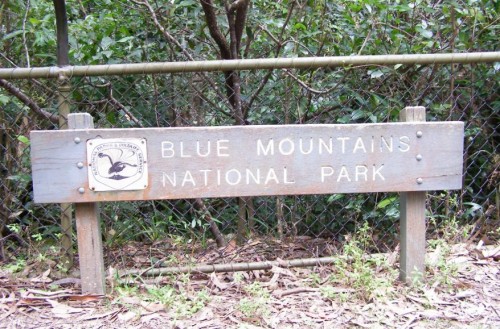
Wildlife Service sets fires to another 3000ha of World Heritage bushland
.
Last Wednesday (18th May 2011) right across the Blue Mountains, thick smoke choked the sky in a eye watering haze. By Friday, an artificial red sunset was blazing through the wood smoke at the end of two days of New South Wales government-sponsored bush arson.
I knew exactly the ecological disaster unfolding, out of sight out of mind.
In its annual misguided winter ritual, the National Parks and Wildlife Service (Wildlife Service), aided and abetted by the Rural Fire Service has deliberately setting fire to remote bushland across The Blue Mountains World Heritage Area – a ‘natural planet asset’ of which the Wildlife Service is international custodian.
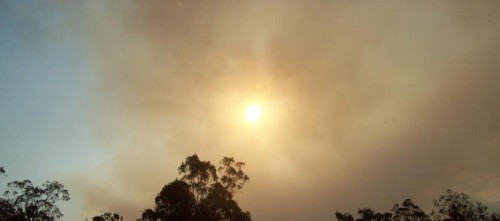
.
Linden Ridge HR Ops (May 2011)
.
On Wednesday afternoon 18th May 2011, the aerial incendiary bombing commenced at Linden Ridge and extended down to the Grose River inside the Blue Mountains National Park (within designated wilderness within the World Heritage Area). Bushfire management euphemistically call it ‘hazard reduction‘ (HR) ; rejecting any notion that bushland habitat is a natural asset, and instead demonising it as a ‘hazard’.
.
Massif Ridge HR Ops (May 2010)
.
The Linden Ridge ‘ops’ follows an almost identical HR ‘ops’ conducted the same time last year on 12 May 2010 in which aerial incendiary ‘ops’ commenced around Massif Ridge some 12 kilometres south of the town of Woodford in wild inaccessible forested area of the World Heritage Area. Some 2500 hectares of high conservation habitat bushland in a protected wilderness area called the ‘Blue Labyrinth’ was indiscriminately incinerated – ridgetops, gullies, everything. Refer to previous article on this website: >’National Parks burning biodiversity‘.
The same Blue Mountains National Park has been targeted by the same aerial incendiary bombing by the same Wildlife Service. Both the operations were carried out under the orders of the Blue Mountains regional manager, Geoff Luscombe.
 This is reducing the ‘hazard’
Click photo to enlarge, then click again to enlarge again and look for anything living.
After a year look for the animals.
After two years look for the animals…. This is reducing the ‘hazard’
Click photo to enlarge, then click again to enlarge again and look for anything living.
After a year look for the animals.
After two years look for the animals….
.
.
.
Gross Valley Defacto HR Ops (Nov 2006)
.
Both the above HR Ops follow the massive conflagration of November 2006, infamously recalled across the Blue Mountains community as ‘The Grose Fire‘. Two abandoned lightning strikes coupled with HR Ops along the Hartley Vale Road and escaping backburns coalesced and incinerated an estimated 14,070 hectares of the Grose Valley and adjoining ridge lands, much of which is designated wilderness. Many consider the actions of the bushfire management response in hindsight to have been a defacto hazard reduction burn. With such an effective elimination of the natural ‘hazard’ that year, as well as the public outrage, HR Ops went quite for four years.

How many animals native to this beautiful Grose Valley suffered an horrific burning death?
How many of their kind have now perished forever from the Grose?
…ask your Wildlife Service at Blackheath!
Charles Darwin in 1836 counted platypus in the area.
.
The perverted rationalisation by bushfire lighting theorists who have infiltrated the Wildlife Service is that the natural bushland, forests and swamps of the Blue Mountains World Heritage Area are perceived not as a valuable natural asset, but as a world ‘hazard’ area to be feared and ‘to be burned in case they burn‘.
These same bushfire lighting theorists have effectively infiltrated, appeased and silenced local conservation groups such as the otherwise very vocal Blue Mountains Conservation Society, the National Parks Association of New South Wales and the umbrella conservation group the New South Wales Conservation Council.
The local conservation movement’s complicity to sanction explicit broadscale ecological harm is a disgraceful and ignoble abandonment of cherished core values, and a breach of duty to faithful environmental membership.
.
.
.
Broadscale indiscriminate ‘HR’ is no different to wildfire or bush arson
The Linden Ridge and Massif Ridge HR Ops were approved and executed by government in the name of ‘hazard reduction’ – to reduce the available ‘fuel’ (native vegetation) for potential future wildfires or bush arson. In both cases, the massive broadscale natural areas burnt were not careful mosaic low intensity burning around houses. This was broadscale indiscriminate fire bombing of remote natural bushland many miles from human settlement. How can the deliberate setting alight of bushland where no fire exists, where no human settlement requires protection from the risk of wildfire be construed but anything other than ‘government-sanctioned bush-arson‘?
.
The ‘Ecological Burn’ Myth
.
When bushfire management can contrive no other excuse for setting fire to native vegetation, such as when that vegetation is many miles away from human settlement and so poses no direct threat, out comes the concocted theory of the ‘ecological burn’. The ‘ecological burn’ theory starts with the premise that because humans have observed that the Australian bush ‘grows back’ (eventually) after a bushfire, it may be concluded that the Australian bush can tolerate bushfires. This hypothesis relies on evidence that selected species of Australian germinate after smoke and fire and the example of epicormic growth of many Eucalypts after fire.
The first deductive fallacy of this theory is that all the Australian bush is bushfire tolerant. This deduction is then extended by unsupported assumption that since the Australian bush is bushfire-tolerant, bushfire must be an integral natural process to which the Australian bush has become adapted to bushfire. The assumption is then extrapolated to assert that bushfire is indeed beneficial to the Australian bush. The assumption is then stretched even further to conclude that without bushfire the Australian bush will be adversely affected. The ecological burn theory then prescribes that by burning the Australian bush, whether by natural or unnatural means, the biodiversity of the Australian bush will be improved.
The deductive fallacy goes further, to suit the motives of the fire-lighters. The outrageous generalisation is made that all the Australian bush must be burnt at some stage for its own ecological benefit. ‘So go forth and burn it. The bush will grow back. It will do it good.’
.
The perverted irrational logic that Australia’s native vegetation has adapted to recover from fire, is akin to claiming the human body is adapted to recover from injury such as burns. A wound may heal but no-one seeks to be injured in the first place. And not all wounds heal. A third degree burn to more than 50% of a human body is almost a certain death sentence. What percentage of a wild animal’s body can be burnt and the animal still survive? That’s a perverted question for the fire-lighters.
Broadscale hazard reduction is not mosaic patch-work fire. It is not creating a small scale asset protection zone around the immediate boundary of a human settlement. It is wholesale bush arson that is driving local extinctions. Ever wonder why when bushwalking through the Australian bush so few native animals are seen these days? Their natural populations have been decimated through two centuries of human harm – mainly poaching, introduced predation and habitat destruction including by human-caused bushfires and human-abandoned bushfires.

The recent concept of the so-called ‘ecological burn’ is a contrivance, a myth. It is a false cause fallacy. Ecological fire a defunct scientific theory contrived by bushfire management engaging unemployed graduates to think up an idea for a PhD. It belongs in the same discarded bucket of defunct scientific theories from days of yore of such ilk as ‘alchemy‘, ‘phlogiston‘, ‘flat earth‘, ‘hollow earth‘ and ‘the birth cries of atoms’ theories. Yup, these were once believed.
[Source: http://www.shortopedia.com/O/B/Obsolete_scientific_theories].
.
The effect on wildlife habitat by broadscale ‘hazard’ reduction is no different than if it was caused by wildfire or bush arson. The hazard to wildlife habitat is the same. The broadscale blanketing of bushland with high intensity burns that reach into the tree tops and scorching ground cover and earth, present the same intense fire regime. The landscape is laid to waste in just the same way as wildfire or bush arson does. Habitat and the wildlife it accommodates become the innocent victims of horrific bushfire, no matter how caused.
There is no wildlife monitoring before, during or after one of these aerial incendiary ‘ops’. Aerial incendiary guarantees no discretion between fire sensitive habitat and fire-resilient habitat. It is a simplistic, convenient a cheap one-size-fits-all solution that re-colours the fire maps to appease political masters. The chopper boys are given their bombing co-ordinates and then do their search and destroy mission. These airborne lads should apply their skills to good and not evil. They should stick to improving their water bombing skills, not participating in this perverted fire-lighting culture.
When the rains follow, the thin yet vital topsoils get washed away into the gullies and streams. This erodes the landscape and prevents regrowth of many flora species due to the lack of vital nutrients. After both the Massif Ridge HR and the Linden Ridge HR, heavy rains did follow.
Only the species of flora adapted to bushfire recover. Fire sensitive species of flora are eliminated from the landscape. Name one species of fauna that is fire tolerant. Where are the zoologists in the Wildlife Service to tell of the impact of the HR? If this mob is providing a ‘service’, it certainly ain’t providing a service to wildlife.
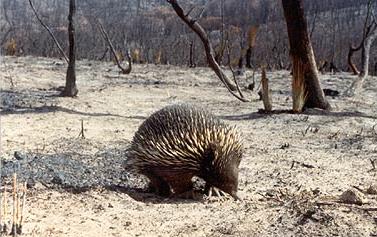
.
.
.
Wildlife Service chief boasts of mass incineration of 92,000 ha of National Parks
.
And the Wildlife Service regional chief for the Blue Mountains region, Geoff Luscombe, in his media release 17th May 2011 boasted of his:
“3000 hectare burn” that “the NPWS carried out more than 92,000 hectares of hazard reduction in 269 burns in 2009/10 – its biggest ever program.”
.
To put this area into perspective, in terms of the Blue Mountains World Heritage Area of about 1 million hectares, such a hazard reduction programme over a decade would decimate the Blue Mountains completely. And they call themselves a ‘Wildlife Service’?
Once again thousands of hectares of pristine flora and fauna habitat in deep inaccessible terrain, miles from houses and human property, has been incinerated from the air using contracted aircraft dropping indiscriminate aerial incendiaries. If only these boys had napalm!
Luscombe confirms in his media release…
“An aircraft will be used to manage the burn as most of the burn will take part in remote areas of the Blue Mountains.”
.
This incineration of natural wildlife habitat is justified by the Wildlife Service as ‘strategic‘ and ‘hazard reduction‘ operations are one of many being conducted by NPWS around the state making the most of the dry sunny winter conditions. This burn is part of the NPWS annual fire management program.
Luscombe again:
…“reducing the volume of fuels within strategic areas of the Park, can assist in limiting the intensity and rate of spread of a wildfire in the area.”
.
Then on Friday 20th May 2011, vertical plumes of smoke were seen rising from Cedar Valley south of the Jamison Valley ~ another one of these secret HR aerial incendiary black ops that the public is not supposed to know about? No notice on either the Blue Mountains Rural Fire Service site or the Wildlife Service site. Out of sight, out of mind.
.
.
.
‘Strategic Fire Management Zones’ – a symptom of a bushphobic cult out of control
.
Under the Blue Mountains Bushfire Management Committee which governs the Blue Mountains region, ‘environmental assets’ are restricted to “threatened species, populations and ecological communities and Ramsar wetlands, locally important species and ecological communities, such as species and ecological communities especially sensitive to fire.”
So how does aerial incendiary discriminate when setting fire to a contiguous 2500 hectares or 3000 hectares of wilderness?
Answer: It doesn’t , it doesn’t seek to, it doesn’t care. The guidelines are only to keep the greenies happy. It’s called ‘greenwashing’.
The Wildlife Service in its official Fire Management Strategy, has relegated 97.7% of the Blue Mountains National Park into either what it calls ‘Strategic Fire Advantage Zones’ or else ‘Heritage Zones. In essence, heritage Zones are valued natural areas that are protected from fire, whereas the Strategic Fire Advantage Zones are expendable. The Wildlife Service proclaims that …due to the ‘relative lack of practical fire control advantages’ (lack of access and resources), Strategic Fire Management Zones are ‘managed’ to protect community assets… to reduce fire intensity… assist in the strategic control… to contain bush fires and to strengthen existing fire control advantages.
All of which simply means is that it is expendable and can and should be burnt in case it burns. Strategic Fire Management Zones ‘are considered priority for ‘treatment‘ – read targeted for broadscale indiscriminate aerial incendiary. So 2500 hectares of wilderness around Massif Ridge copped it last winter and 3000 hectares of wilderness around Linden Ridge copped it this winter. If it’ red on the fire map, burn it!
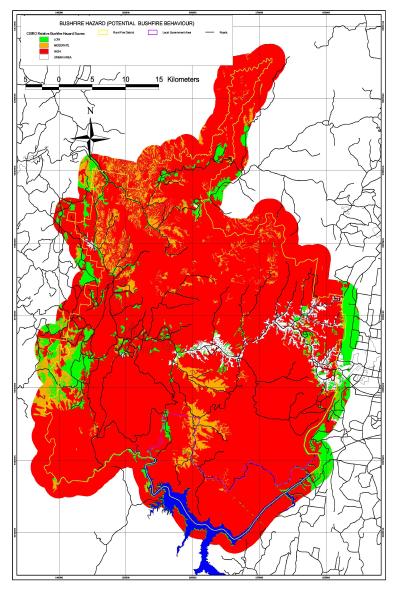
What do these ecological vandals get up to deep in the wilderness at night with their matches and petrol drip torches out of the direct view of the public? They put up signs to deny public access to their nefarious activities. Out of the public view, they are out of sight out of mind.
A cult is a group whose beliefs or practices are considered abnormal or bizarre. Starting large bushfires would seem to fit that definition. Fire-lighting is a cult of ecological deviance, just like any form of arson.
.
.
Precautionary principle ignored
.
“Where there are threats of serious or irreversible environmental damage, lack of full scientific certainty should not be used as a reason for postponing measures to prevent environmental degradation.” [Source: Principle 15 of the Rio Declaration (1992)] Such is the internationally agreed precautionary principle which Australia has adopted as a guiding principle of environmental management. The National Strategy for Ecologically Sustainable Development (1992) adopts the precautionary principle as a “core element” of ESD as does the Inter-Governmental Agreement on the Environment, and the Wildlife Service is supposed to be bound by it in its management of National Parks.
The Wildlife Service once a trusted upholder of the science-based ‘precautionary principle‘ has of late succumbed to the more red neck bushphobic fear of the bush. What the general public hears about the Wildlife Service these days is its broadscale fire bombing of vast areas of vegetation in its ‘protected’ National Parks. This is confirmed these days by the wood smoke-filled air choking many communities and responsible for unknown volumes of smoke emissions contributing to net human-caused pollution to the planet – what many call ‘climate change’.
In the Wildlife Service’s Plan of Management for the Blue Mountains National Park the only reference to the precautionary principle is “Maximum levels of total commercial recreational use in the park will be set for particular activities and particular locations according to precautionary principles.” (p.84) In its Fire Management Strategy for the Blue Mountains, the only reference to the precautionary principle is “the precautionary approach will generally be applied in the absence of specific information.” (p.53)
Clearly the Wildlife Services respect for the precautionary principle is tokenistic, and wholeheartedly disregarded with its use of aerial incendiaries. The Blue Mountains delicate ecosystems are vulnerable to the indiscriminate fire regimes being imposed upon them. The burning into the tree canopy, the broadscale contiguous burning, the scorching of the landscape until bare earth can be seen is highly damaging to the many micro ecosystem across the Blue Mountains. When such burning occurs what happens to the micro-organisms, fungi species and the natural soil biota?
.
” Much hazard reduction is performed to create a false sense of security rather than to reduce fire risks, and the effect on wildlife is virtually unknown.”
~ Michael Clarke (Associate Professor, Department of Zoology, La Trobe University, 2008)
.
.
.
.

A discredited Wildlife Service
.
The once trusted and respected Wildlife Service has lost its conservation way. It now spends more time, money and training on burning fragile ecosystems in its National Parks and exploiting those same parks for tourism exploitation, than it does on wildlife habitat rehabilitation. Sydney’s Taronga Zoo has become far more active and valuable in its urban wildlife recovery programmes than the Wildlife Service is in the wild.
At the carpark above Katoomba Falls within the Blue Mountains National Park, a rather old and deteriorating sign put up by the Wildlife Service years ago, conveys a conservation message to park users. The last two sentences are particularly poignant in light of the massive scale of broadscale bush arson repeatedly being inflicted by the protectorate of the National Park – the Wildlife Service. If only the Wildlife Service would “leave nothing but footprints” and follow its own maxim.
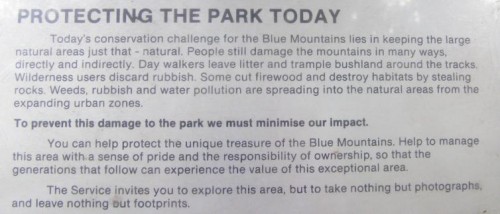
Indiscriminate bush arson of remote bushland in a National Park shows that the Wildlife Service has descended into a predatory wolf in sheep’s clothing. It’s management cannot be trusted with its custodial responsibility to protect the unique treasure of the Blue Mountains.
Once I had a desire to embark on a career as a National Parks Ranger. Had I, in the end, I would have morally wrestled with the hypocritical politics and lasted less than the initial probationary period. I empathise with those who hold a personal commitment to ecology and environmentalism within the Wildlife Service.
.
.
.
The key drivers of the ‘HR Culture’
.

The perverted and unquestioned rush to set fire to as much bushland as possible across the Blue Mountains and indeed across Australia is being driven by five cultural factors:
- ‘Ecological Fire’ Myth. (as described above) Certain ”fire ecologists’ (a self-described term for many seeking to make this a lucrative profession) who are funded by bushfire management agencies, not surprisingly have conjured the academic theory that burning the bush is good for it because it increase biodiversity – just what bushfire management with their cheque book want to hear! They have conjured the term ‘ecological fire‘, which as a euphemism sounds good, so it must be good. So those setting fire to the bush may have no moral qualms. Crap. Show me any native fauna that proliferate after fire – ‘ecological’ or otherwise!
- Under-Resourced. Bushfire management is being repeatedly denied the necessary resources and technologies to quickly detect, respond to and suppress bushfore ignitions as and when they do occur, so there is a mindset of futile frustration that nothing can be done to stop bushfires frequently getting out of control.
- Bushphobic Extremists have become effective in their fear campaign to influence natural land managers, politicians and the media in their one dimensional theory that if bushland is not burnt to remove ‘fuel loads’ catastrophic firestorms will inevitably bring forth Armageddon. They preach that only the wholesale removal of forests will prevent wildfire. (Replacement with concrete would prevent it too.) Their constant evangelising reaches such irrational hysteria, that in order to appease them, HR Ops are promised and executed just to keep them at bay.
- False Sense of Security. ‘Much hazard reduction is performed to create a false sense of security’ (James Woodford, 8-9-2008). But how is burning remote bushland many kilometres from the human interface, allaying human security concerns? Yet hazard reduction is known to directly cause a sharp increase in fuel loads due to an unnaturally high and uniform germination of understory plants.
- Winter Idleness. Fire fighting naturally quietens off during the cooler wetter month of winter, and since Australian bushfire management agencies in the main only do bushfire management rather than throw on an SES jacket, multi-task in complimentary emergency management; many bushfire agencies are perceived (rightly or wrongly) as being idle over winter. So HR gives ’em all something to do!
.
.
.
The Wildlife Service must ‘love the smell of napalm (and smoke) in the morning’
.

The Wildlife Service undertaking these remote HR Ops, sending in the airborne firelighters, must be like watching the Huey helicopter beach attack scene in Francis Coppola’s 1979 film Apocalypse Now, based on Joseph Conrad’s novel ‘A Heart of Darkness’. Colonel Kilgore in his black Confederate cowboy hat shouts:
“We’ll come in low out of the rising sun, then about a mile out we’ll put on the music; scares the hell out of the slopes.”
Richard Wagner’s “Ride of the Valkyries” is played and the boys play war games with real aircraft and real fire and causing real death and destruction.
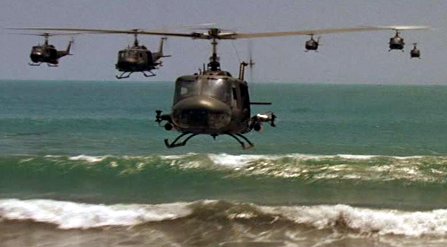
A giant napalm strike in the nearby jungle dramatically marks the climax of the battle. Kilgore exults to Willard, “I love the smell of napalm in the morning… The smell, you know that gasoline smell… Smells like … victory”, as he recalls a battle in which a hill was bombarded with napalm for over twelve hours.

The Wildlife Service aerial incendiary boys must think of themselves as Special Forces. Perhaps there is a Colonel Kurtz among them – like an insane killer operating deep inside Laos. Kurtz’ final lines in the film are “The horror! The horror!” How comparable with what is happening deep inside Australia’s wilderness areas, out of sight out of mind? …with extreme prejudice!

How comparable is the US secret war fire bombing of Vietnam, Cambodia and Laos during the Vietnam War with the out of sight fire bombing by the Wildlife service of vast areas of Australia’s natural landscape?
The legacy of the Wildlife Services’ aerial incendiary campaigns deep inside National Parks will be one remembered for fire bombing wildlife habitat from once natural and densely vegetated into a one unnatural, sterile and ghostly quiet.
When it is too late, hazard reduction will be acknowledged by our children as naiive threatening process of our generation that drove Australia’s remaining wildlife into extinction.
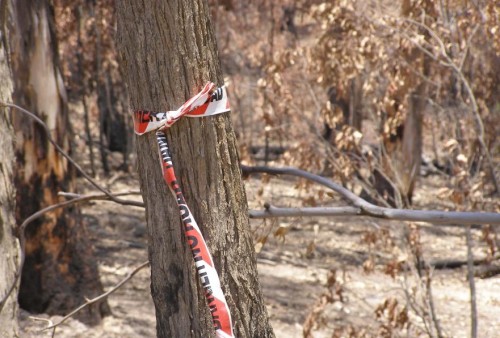
.
.
Further Reading:
[1] ‘ Catering for the needs of fauna in fire management: science or just wishful thinking?’ by Michael F. Clarke, Wildlife Research, Vol. 35 No. 5 Pages 385 – 394, Published 19 August 2008, ‘Ecological fire management in Australia is often built on an assumption that meeting the needs of plant species will automatically meet the needs of animal species. However, the scarcity of..’. ‘Wildlife Research: Ecology, Management and Conservation in Natural and Modified Habitats’, a CSIRO Journal, ISSN: 1035-3712, eISSN: 1448-5494, Available for subscription at http://www.publish.csiro.au/index.cfm
[2] ‘ The dangers of fighting fire with fire‘, by James Woodford, Sydney Morning Herald, 20080908, p.11, http://www.smh.com.au/news/opinion/the-dangers-of-fighting-fire-with-fire/2008/09/07/1220725850216.html (Accessed 20110523).
-end of article –
Tags: aerial incendiaries, applied ecology, blue labyrinth, Blue Mountains National Park, Blue Mountains wildlife, Blue Mountains World Heritage Area, bushfire myth, bushfire tolerant, bushphobic, conservation biology, ecological burn, fire-lighting cult, fuels, government bush-arson, greenwashing, Grose Valley Fires 2006, hazard reduction, heritage zone, koala extinction, leave nothing but footprints, Linden Ridge HR, Massif Ridge HR, NPWS, precautionary principle, prescribed burning, RFS, strategic fire advantage zone, strategic fire management zone, wildfire, Wildlife Service
Posted in Blue Mountains (AU), Threats from Bushfire | No Comments »
Add this post to Del.icio.us - Digg
Saturday, May 14th, 2011
In the north-western area of the Blue Mountains region of New South Wales (eastern Australia) lies the ancient Gardens of Stone. The area is so named because of its spectacular and rare sandstone rock formations known as ‘pagodas’ (large tapered, stepped or laminated sandstone formations) along with the abundance of native flora and fauna that thrive there.
Yet since November 2009, part of this beautiful pagoda country (some 1088 hectares of the Ben Bullen State Forest) with its important wildlife habitat, has come under threat of destruction from proposed open cut coal mining.
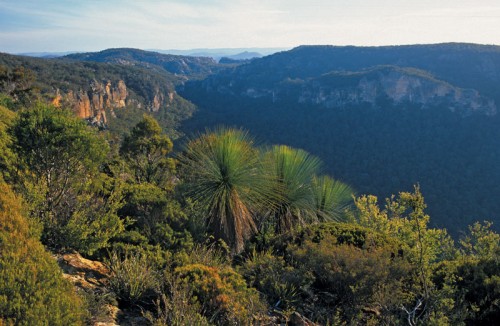 Johnson’s Grass Trees on Genowlan Mountain
© Photo by Jaime Plaza van Roon
(click photo to enlarge) Johnson’s Grass Trees on Genowlan Mountain
© Photo by Jaime Plaza van Roon
(click photo to enlarge)
.
Gardens of Stone National Park
.
In 1994, a Gardens of Stone National Park was created covering 15,000 hectares and joining Wollemi National Park on the northern part of Newnes Plateau. Other large landscape features include the outstanding mesas of Donkey Mountain in the Wolgan Valley and Pantoneys Crown in the Capertee Valley. Pantoneys Crown was previously protected in a much smaller nature reserve, and is the centrepiece of the commanding view of the valley from Pearsons Lookout on the Castlereagh Highway.
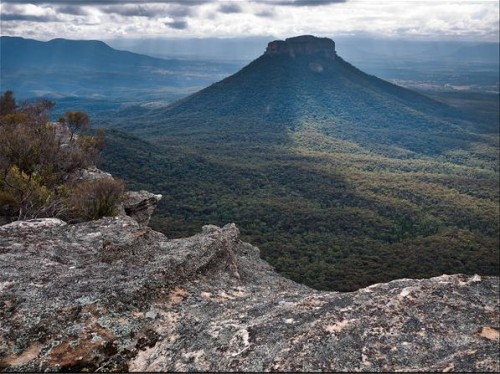 Pantoneys Crown, Gardens of Stone National Park, NSW
© Photo by David Braddon-Mitchell
[Source: ^http://dbm305.smugmug.com/Other/Pantoneys-Crown/13102823_B2fHx#950356269_VhEUF]
(click photo to enlarge) Pantoneys Crown, Gardens of Stone National Park, NSW
© Photo by David Braddon-Mitchell
[Source: ^http://dbm305.smugmug.com/Other/Pantoneys-Crown/13102823_B2fHx#950356269_VhEUF]
(click photo to enlarge)
.
Gardens of Stone Proposed Stage 2
‘But Gardens of Stone is an unfinished park. Environment groups, including Blue Mountains Conservation Society, have advanced a plan to protect much more of this unique landscape, by extending the park and creating a new state conservation area over adjacent plateaus and escarpments which are presently state forest and Crown land. The overall proposal is known as Gardens of Stone Stage 2, situated just north of the town of Lithgow. (The state conservation area classification allows underground coal-mining to continue.)
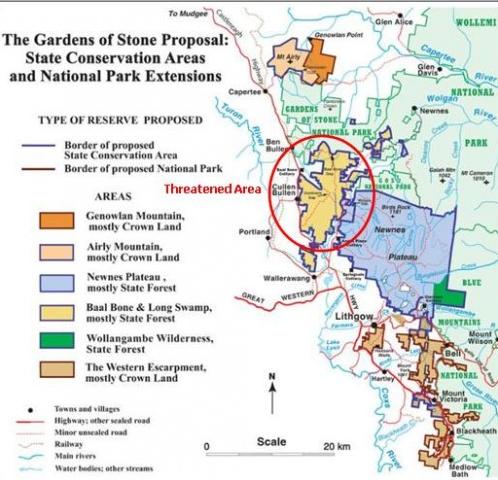 [Source: ^http://www.bluemountains.org.au/gos2.shtml] [Source: ^http://www.bluemountains.org.au/gos2.shtml]
‘These unprotected areas are just as valuable as the existing park, and are rich in special environments such as pagodas and canyons, nationally endangered high altitude shrub swamps and an unusual heathland on Genowlan Mountain. Rare and threatened species include the beautiful yellow Pagoda Daisy, Deane’s Boronia, Blue Mountains Water Skink, Wolgan Snow Gum, Giant Dragonfly, Regent Honeyeater, Genowlan Pea and Beautiful Firetail. In the western parts of the area the moist mountain vegetation begins to give way to drier inland communities, including grassy box woodlands, one of the most diminished and threatened environments in Australia.
‘The Gardens of Stone Stage 2 provides one of the most beautiful displays of sandstone geodiversity in Australia, comprising dramatically coloured sandstone escarpments and promontories, narrow canyons, cave overhangs, swamps and the complex arrays of rock pinnacles known as pagodas. The area has one of the Blue Mountains’ areas of highest plant diversity including ancient windswept montane heathlands, nationally endangered upland swamps, a unique species of snowgum (E. gregsoniana) and other high plateau woodlands representing the highest development of native vegetation on Sydney Basin sedimentary rocks, poorly conserved grassy white box woodlands on slopes below the sandstone, fascinating oil shale mining ruins on spectacular Airly Mesa, and outstanding Aboriginal cultural sites on and around Newnes Plateau.
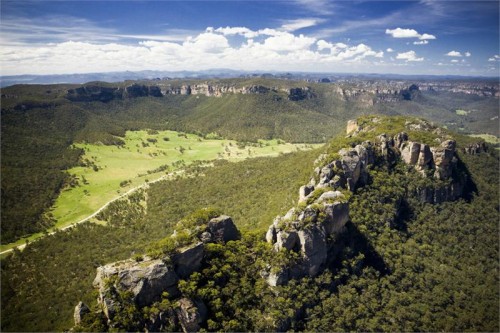 Gardens of Stone
© Photo by Hamilton Lund, Tourism NSW
Blue Mountains – Visit NSW, ^http://www.visitnsw.com/destinations/blue-mountains (click photo to enlarge) Gardens of Stone
© Photo by Hamilton Lund, Tourism NSW
Blue Mountains – Visit NSW, ^http://www.visitnsw.com/destinations/blue-mountains (click photo to enlarge)
.
The area embraces the last unprotected part of the 1934 Greater Blue Mountains National Park proposal compiled by Myles Dunphy for the National Parks and Primitive Areas Council. It also includes the Blue Mountains Western Escarpment lands from Blackheath to Lithgow. The Gardens of Stone Stage 2 proposal advanced by The Colong Foundation for Wilderness, the Blue Mountains Conservation Society and the Colo Committee is to include all of the remaining parts of Newnes Plateau and surrounding sandstone uplands – an area of 40,000 hectares. It would protect the most spectacular pagoda landscapes in Australia.
Associated with these pagoda landforms are found large caves, mazes, ancient montane heathlands, endangered upland swamps, snowgums, grassy woodlands and moist gullies that contain tree ferns, stands of old growth forest and rainforest, and, in some places, slot canyons.
Reservation of Stage Two would also secure the outstanding ochre coloured cliffs of the Blue Mountains’ Western Escarpment and the rare plant communities that lie above them. Reservation of the remaining unprotected parts of the Gardens of Stone as a State Conservation Area is urgently required to rein in ongoing and accelerating environmental degradation.
[Sources: Gardens of Stone National Park, http://www.worldheritage.org.au/resources/national-parks/gardens-of-stone-national-park/ and Blue Mountains Conservation Society, http://www.bluemountains.org.au/gos2.shtml]
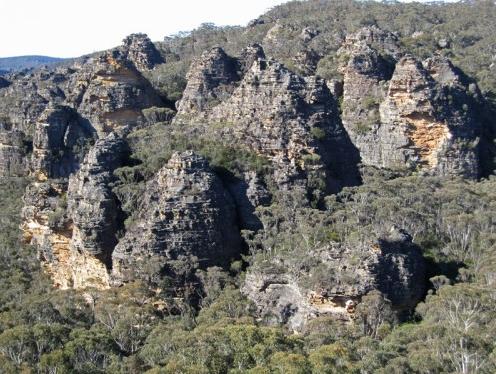 Pagodas of the Gardens of Stone (still outside the National Park) Pagodas of the Gardens of Stone (still outside the National Park)
© Photo by Andrew Valja
[Source: Blue Mountains Conservation Society, http://www.bluemountains.org.au/gos2.shtml]
(click photo to enlarge)
.
.
.

Threats from Coalpac Pty Ltd
.
CoalPac is a private Queensland coal mining company headquartered in Pullenvale in outer eastern Brisbane. In 1989, CoalPac took over coal mining operations outside the town of Lithgow in New South Wales, at the Cullen Valley Open Cut Mine and the Invincible Open Cut Mine. The Mines currently operate at 2 mtpa and Coalpac has plans for significant expansion of coal mines in the Gardens of Stone area.
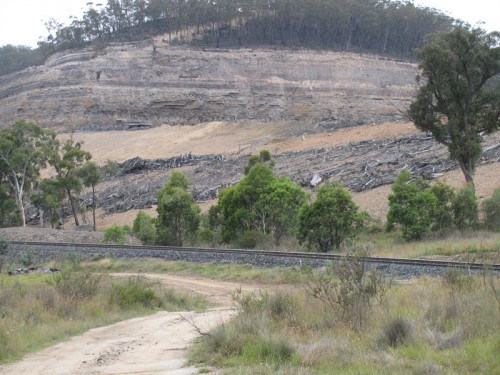 Coalpac’s CullenValley Mine
[Source: Lithgow Environment Group, Inc.]
(click photo to enlarge) Coalpac’s CullenValley Mine
[Source: Lithgow Environment Group, Inc.]
(click photo to enlarge)
.
‘Coalpac is seeking approval for the consolidation and expansion of the existing Cullen Valley Mine and Invincible Colliery operations to produce up to a total of 3.5 million tonnes per annum.’ [Source: http://cetresources.com/about-us]
This proposed extension of its open-cut and highwall mining will intrude into a large area of the publicly-owned Ben Bullen State Forest (BBSF), NSW. The extension area is equivalent of 2,176 football fields of predominantly old growth forest will be clear-felled and excavated if this goes ahead. The pagoda’s features and stability may be threatened by collapse.
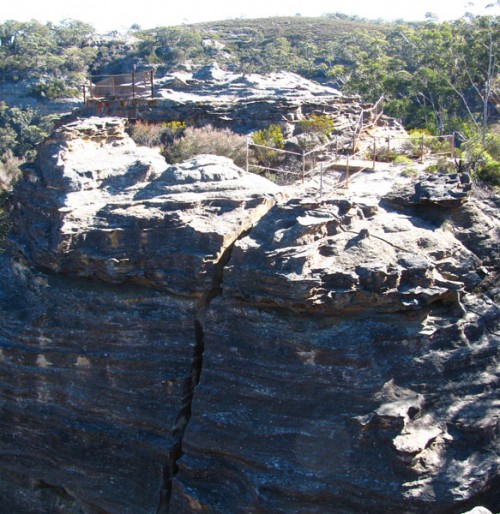 Cracked Hassans Walls, Lithgow ~ caused by nearby mining
[Source: Lithgow Environment Group, Inc.] Cracked Hassans Walls, Lithgow ~ caused by nearby mining
[Source: Lithgow Environment Group, Inc.]
.
“The NSW National Parks and Wildlife Service (now within the Office of Environment and Heritage) has acknowledged its wish to add BBSF to the conservation reserve system as a matter of priority” says Lachlan Garland, President of the Blue Mountains Conservation Society.
“Allowing this operation would mean the equivalent of 2,176 football fields of predominantly old growth forest of the BBSF being clear-felled and excavated.
“This forest is a publicly-owned area of conservation and recreational importance. The community expects state forests to be protected from destruction in perpetuity.
 ‘Baal Bone Creek’ area at risk
©Photo by Ian Brown.
‘Baal Bone and Long Swamp (7,800 hectares) comprise massed pagoda ‘villages’ above the Long Swamp, a diverse swampy plain. They collectively form an evocative landscape of broken stone, reminiscent of Cambodia’s forest of State Forest temples, while nearby indigenous cave art honours this landscape.’
(click to enlarge, then click again to enlarge further) ‘Baal Bone Creek’ area at risk
©Photo by Ian Brown.
‘Baal Bone and Long Swamp (7,800 hectares) comprise massed pagoda ‘villages’ above the Long Swamp, a diverse swampy plain. They collectively form an evocative landscape of broken stone, reminiscent of Cambodia’s forest of State Forest temples, while nearby indigenous cave art honours this landscape.’
(click to enlarge, then click again to enlarge further)
.
“Habitats for the Regent Honeyeater, Tiger Quoll and Powerful Owl and at least 32 threatened native animals, 5 of which are listed under the EPBC Act, will be completely removed.
“Our iconic Lyrebirds also use the sides of pagodas to nest and raise their young. Mining will completely remove the protective pathways for adult birds foraging between nesting sites and will destroy their food habitats within the more fertile valley floors.
“The effective privatisation and liquidation of a large part of the forest is an outrageous precedent that should not be set; it is a direct challenge to the state’s efforts to reduce deforestation.
“The Blue Mountains Conservation Society seeks to work with the Minister for the Environment and Heritage, Robyn Parker, to continue our important work and safeguard the future of the Gardens of Stone.
“We invite all politicians to visit the Gardens of Stone area with us on Sat 14th May, 2011 to see first hand the stunning areas under threat from mining.”
The NSW Department of Planning finalised the Director-General’s Requirements (guidelines) for the Environmental Assessment on 16 October 2010. The proponent is preparing the Environmental Assessment. Once finalised, this will be released for public comment. The project, prior to the election of the NSW Coalition Government, was to be assessed by an accredited process under Part 3A, which on 7th April 2011 was scrapped by the incoming O’Farrell Liberal Government of New South Wales. [read article below]
 The very yellow Pagoda Daisy (at risk)
©Photo by Ian Brown
(click to enlarge, then click again to enlarge further) The very yellow Pagoda Daisy (at risk)
©Photo by Ian Brown
(click to enlarge, then click again to enlarge further)
.
Environment groups take action to protect Gardens of Stone
The uniquely scenic and biodiverse Gardens of Stone is under imminent threat due to a consolidation proposal by Coalpac Pty Ltd. If approved, wildlife habitat and natural heritage will be lost forever, water systems will be stressed and there would be direct impacts for local residents. On Saturday 14th May, 2011 environment groups and their supporters will be taking action to help protect this iconic landscape from irredeemable destruction.
“Coalpac Pty Ltd seeks to extend open-cut and highwall mining into a large area of the publicly-owned Ben Bullen State Forest, NSW. The NSW National Parks and Wildlife Service has acknowledged its wish to add this forest to the conservation reserve system as a matter of priority” says Tara Cameron, Vice President of Blue Mountains Conservation Society.
“Many of the highwall scarps will abut strata directly below the ‘pagoda’ rock formations, their features and stability may be threatened by collapse. Environment groups are outraged at this proposal” says Tara Cameron.
“This forest is a publicly-owned area of conservation and recreational importance. The community expects state forests to be protected from destruction in perpetuity. If the NSW Government’s Strategic Regional Landuse Policy is to mean anything for sensitive, natural lands, then the Gardens of Stone must be protected from destructive mining operations, ” says Keith Muir, Director of Colong Foundation for Wilderness.
“This landscape is biodiversity hotspot, characterised by rich old-growth forests. Our iconic Lyrebirds use the sides of pagodas to nest and raise their young. Mining will completely remove their food habitats as well as the habitats of at least 32 threatened native animals” says Belinda Fairbrother, Campaigns Manager for The Wilderness Society NSW.
“Water management and impacts over such a large, exposed open-cut area are of great concern. The large open cut will also create significant dust and air quality issues which will impact directly on local residents” says Caroline Graham, Vice President of Rivers SoS.
“Environment groups are calling on the government to reject this mining proposal and act to protect the region within a State Conservation Area. We are coming together at this event to send a clear message that ‘We say No to open cut mining!’ in this iconic area of our state” says Kevin Evans, EO of National Parks Association of NSW.
“Across NSW, areas of high conservation value and great beauty are under threat from the rapid expansion of the coal and coal seam gas industries. During this time of transitional arrangements on the regulation of coal mining, the State government has an opportunity to deliver on its promise of better protection of water resources and the environment by rejecting further mining at the iconic Gardens of Stone,” says Pepe Clarke, CEO of the Nature Conservation Council of NSW.’
[Source: National Pars Association of NSW, http://www.npansw.org.au/index.php?option=com_content&view=article&id=718:environment-groups-take-action-to-protect-gardens-of-stone&catid=172:2011&Itemid=564]
.
.
‘Part 3A scrapped’
[8 Apr 11, by Tyron Butson, Southern Courier newspaper, http://southern-courier.whereilive.com.au/news/story/part-3a-scrapped/]
PREMIER Barry O’Farrell has given increased planning powers back to local councils after scrapping the controversial Part 3A amendment.
He announced the decision to drop Part 3A of the 1979 Environmental Planning and Assessment Act at yesterday’s first State Cabinet meeting.
Local councils will now have final say on many outstanding applications, while others will be referred to the NSW Planning Assessment Commission.
No new Part 3A application for residential, commercial, retail or coastal development will be accepted and the State Government hope to push through legislation that will see the amendment repealed from the Statute books when Parliament resumes.
“This means a return of planning powers to councils and local communities,” Mr O’Farrell said.
“The days of giving the Planning Minister sweeping powers to approve developments at the stroke of a pen with virtually no consultation with local communities are over.
“That extreme power only leads to the sort of suspicion and shady deals we have seen in NSW over the past 16 years.”
The scrapping of Part 3A was a core election promise of the Liberal party, but the government will still have to push legislation through the Upper House.
Mr O’Farrell said he had not attempted to convince opposition members but had directed the Minister for Planning Brad Hazzard to draw up plans.
Until then transitional arrangements will be put into place to deal with more than 500 Part 3A applications already in the system.
About half of the applications will now face the Planning Assessment Commission for assessment, while the rest will either be sent to local councils to vote on or allowed to lapse.
Part 3A was introduced in 2005 and gave planning ministers the ability to overrule local councils and communities on any project the minister deemed to be of state or regional importance.’
.
.
‘Cliffs crumbled due to coal mining, says new report’
(by Ben Cubby, Environment Editor, Sydney Morning Herald, April 27, 2010)
‘DOZENS of cliffs have crumbled or collapsed, Aboriginal rock art has been destroyed and metre-wide cracks opened in the earth as a result of coalmining in the Gardens of Stone wilderness area near Lithgow, an independent report has found.
The damage, inflicted over three decades by five coal mines and continuing today, is caused by subsidence from longwall mining, which now almost surrounds the Gardens of Stone National Park, part of the Greater Blue Mountains World Heritage Site. It is likely to be extended further if a new mine plan is approved by the NSW government.
The report, to be launched today by the former premier Bob Carr, documents wide-scale, unpublicised damage, including the destruction of some of the area’s unique sandstone pagodas and rock arches.
”In its monitoring reports to government, the coal industry regularly understates the damage caused,” said Keith Muir, the executive officer of the Colong Foundation for Wilderness, which produced the report. ”Mine operations do not work to minimise environmental damage and have been largely unresponsive to environmental concerns.”
The study based this conclusion on visual observation in the remote bushland and examination of the the environmental assessments used to justify the expansion of mining. In some cases, the assessments predicted that cliffs could crumble but no remedial action was taken.
The report looks at the six coalmines around the national park: the Angus Place, Springvale and Airly mines operated by Centennial Coal, Baal Bone and Clarence collieries operated by Coalex, and Invincible mine, operated by Coalpac. All the mining companies have met the requirements of their environmental assessment processes and have continued to monitor the impact of subsidence.
Reports produced by consultants employed by the companies showed more than 100 recorded cliff falls in the past three decades. Some led to changes in sites and techniques, but in the majority of cases the warnings were not heeded.
The damage was significantly worse above longwall mines, which cut out long, broad panels of coal, leaving the surface above to crack and subside. The Clarence and Airly mines use the bord and pillar technique, which involves leaving more coal in the ground to support the rock above, resulting in less surface damage.
Aboriginal rock art sites were also photographed with major fractures running through them and, in some cases, entire rock faces destroyed by the effects of subsidence.
”Crevasses, cliff falls and rock fractures are spoiling the sandstone beauty of the Gardens of Stone,” Mr Muir said.
The organisation is calling for a state-sanctioned conservation area that would provide a buffer zone around the park. It would cover part of the Baal Bone mine area, where a further expansion is planned, and the Newnes Plateau, where many swamps have been drained when the rock beneath them cracked open.
”The Department of Environment, Climate Change and Water has been considering proposals for additions to the Gardens of Stone National Park and an evaluation process is under way,” a spokeswoman said.
Read more: http://www.smh.com.au/environment/cliffs-crumbled-due-to-coalmining-says-new-report-20100426-tnbk.html#ixzz1MGS62mRx
.
.
Previously in 2007…
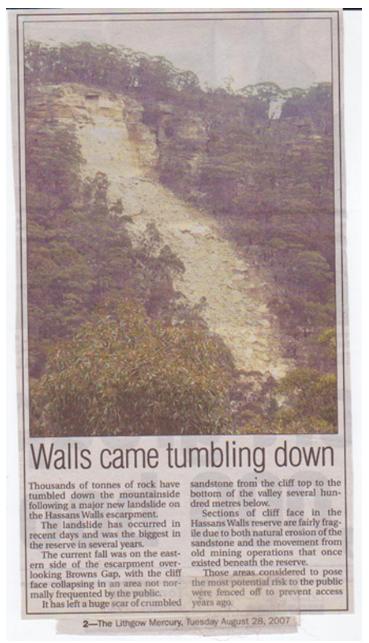
.
.
Further Reading:
.
[1] Previous article on this website: ‘Gardens of Stone at Risk from Coal Mining’, > https://www.habitatadvocate.com.au/?p=4021
[2] Blue Mountains Conservation Society, ^http://www.bluemountains.org.au/gos2.shtml
[3] Gardens of Stone National Park, ^http://www.worldheritage.org.au/resources/national-parks/gardens-of-stone-national-park/
[4] The Colong Foundation for Wilderness, ^ http://www.colongwilderness.org.au/Gardens_of_Stone/GoS2_home.htm
[5] Lithgow Environment Group, Inc. ^http://www.lithgowenvironment.org/mine_watch.html
[6] Lithgow Tourism, ^http://www.lithgow-tourism.com/gardenstone.htm
[7] Rivers SOS, ^http://riverssos.org.au/2011/04/27/help-us-protect-the-gardens-of-stone/
[8] National Parks Association of NSW, ^http://www.npansw.org.au/index.php?option=com_content&view=article&id=718:environment-groups-take-action-to-protect-gardens-of-stone&catid=172:2011&Itemid=564
[9] ‘Cliffs crumbled due to coalmining, says new report’, by Ben Cubby, Sydney Moring Herald, April 27, 2010, ^http://www.smh.com.au/environment/cliffs-crumbled-due-to-coalmining-says-new-report-20100426-tnbk.html

– end of article –
Environment groups take action to protect Gardens of Stone
The uniquely scenic and biodiverse Gardens of Stone is under imminent threat due to a consolidation proposal by Coalpac Pty Ltd. If approved, wildlife habitat and natural heritage will be lost forever, water systems will be stressed and there would be direct impacts for local residents. On Saturday 14th May, 2011 environment groups and their supporters will be taking action to help protect this iconic landscape from irredeemable destruction.
“Coalpac Pty Ltd seeks to extend open-cut and highwall mining into a large area of the publicly-owned Ben Bullen State Forest, NSW. The NSW National Parks and Wildlife Service has acknowledged its wish to add this forest to the conservation reserve system as a matter of priority” says Tara Cameron, Vice President of Blue Mountains Conservation Society.
“Many of the highwall scarps will abut strata directly below the ‘pagoda’ rock formations, their features and stability may be threatened by collapse. Environment groups are outraged at this proposal” says Tara Cameron.
“This forest is a publicly-owned area of conservation and recreational importance. The community expects state forests to be protected from destruction in perpetuity. If the NSW Government’s Strategic Regional Landuse Policy is to mean anything for sensitive, natural lands, then the Gardens of Stone must be protected from destructive mining operations, ” says Keith Muir, Director of Colong Foundation for Wilderness.
“This landscape is biodiversity hotspot, characterised by rich old-growth forests. Our iconic Lyrebirds use the sides of pagodas to nest and raise their young. Mining will completely remove their food habitats as well as the habitats of at least 32 threatened native animals” says Belinda Fairbrother, Campaigns Manager for The Wilderness Society NSW.
“Water management and impacts over such a large, exposed open-cut area are of great concern. The large open cut will also create significant dust and air quality issues which will impact directly on local residents” says Caroline Graham, Vice President of Rivers SoS.
“Environment groups are calling on the government to reject this mining proposal and act to protect the region within a State Conservation Area. We are coming together at this event to send a clear message that ‘We say No to open cut mining!’ in this iconic area of our state” says Kevin Evans, EO of National Parks Association of NSW.
“Across NSW, areas of high conservation value and great beauty are under threat from the rapid expansion of the coal and coal seam gas industries. During this time of transitional arrangements on the regulation of coal mining, the State government has an opportunity to deliver on its promise of better protection of water resources and the environment by rejecting further mining at the iconic Gardens of Stone,” says Pepe Clarke, CEO of the Nature Conservation Council of NSW.
Tags: Baal Bone, Barry O'Farrell, Ben Bullen State Forest, Blue Mountains World Heritage Area, Capertee Valley, Coal Mining, Coalpac Pty Ltd, Gardens of Stone, Genowlan Mountain, Hassans Walls, Lithgow Coal, Minister for Planning Brad Hazzard, Minister for the Environment and Heritage Robyn Parker, Newnes Plateau, Pantoneys Crown, Part 3A, Powerful Owl, Regent Honeyeater, Tiger Quoll, Wolgan Valley
Posted in Blue Mountains (AU), Threats from Mining | No Comments »
Add this post to Del.icio.us - Digg
Tuesday, May 3rd, 2011
 Fraser Island Dingo
[Source: ^http://widebaygreens.org/fraser-island/] Fraser Island Dingo
[Source: ^http://widebaygreens.org/fraser-island/]
.
‘The dingo population on (Fraser) island is regarded as the most pure strain of dingoes remaining in eastern Australia’.
~ ^UNESCO World Heritage
.
‘Dingoes were once common on the island, but are now decreasing. They are some of the last remaining pure dingoes in Eastern Australia and to prevent cross-breeding, dogs are not allowed on the island. There was no recorded history of dingoes attacking humans on Fraser Island up until 1995.
In April 2001, a boy wandered away from his family and was discovered dead, with indications of a dingo attack. Thirty-one dingoes were killed by authorities as a result of the incident. In 2004, a dingo entered a hotel room on the island where a baby was lying on a bed. It was chased off before any incident occurred. Feeding or attracting the attention of dingoes remains illegal.
The remaining number of dingoes on the island is estimated to be 120 to 150 as of January 2008 and sightings are becoming rarer.’
[Source: ^ http://widebaygreens.org/fraser-island/]
.
.
.
Need to Control Humans
.
Given the recent history of parental negligence on Fraser Island, has it got to the point of mandating an ‘Adults Only’ responsible presence on Fraser Island?
Such a respectful ecological policy would ensure that only responsible human adults share and respect Fraser Island without risking more starving dingos to be shot in some twisted vengeance by so-called ‘wildlife officers’.
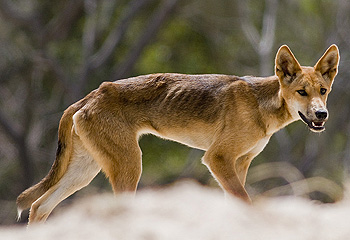 Australia’s national disgrace – starving dingos cornered on their native Fraser Island
[Source: ^http://www.care2.com/news/member/525884267/1440667] Australia’s national disgrace – starving dingos cornered on their native Fraser Island
[Source: ^http://www.care2.com/news/member/525884267/1440667]
.
What is the Queensland Government’s latest brand name for its agency responsible for Fraser Island’s supposed World Heritage values? – ‘Department of Environmental Resource Management‘ – who’s flaming resource? Is Queensland still redneck about tourism revenue and exploitation of this World Heritage tourism brand?.
Dingos are wild Australian animals.
Why haven’t Australian tourists learnt from Australia’s Azaria Lesson that children and wildlife don’t mix?
“The Fraser Island Dingo is believed to be the purest strain of Dingo on the East Coast of Australia. It is illegal to feed or touch the Dingoes as it causes the animals to become “humanised”. There have been recorded instances of Dingoes attacking humans with the fatal attack of a 9 year old boy. This is not a regular occurence and if people are aware of the danger then these instances can be minimised.”
[Source: ^http://ozmagic2.homestead.com/dingo.html]
.
.
.
Need to Restore Dingo Ecology on Fraser Island
.
The problem of the health, viability and survivability of Fraser Island Dingos is a joint responsibility of the Queensland Government and Australian Government.
Why the deliberate slaughter of dingos by the very Government agency charged with Fraser Island’s ecological integrity: ‘Department of Environmental Resource Management‘?
‘The recent slaughter of a very large number of one of the last genetically pure populations of dingoes in Australia (on Fraser Island) has prompted an overwhelming call by our member organisations to press for better protection for dingoes, both from acts of State-sanctioned cruelty and from the extreme and urgent threat of extinction.’
[Source: ^http://www.awpc.org.au/other_fauna/dingo1.htm]
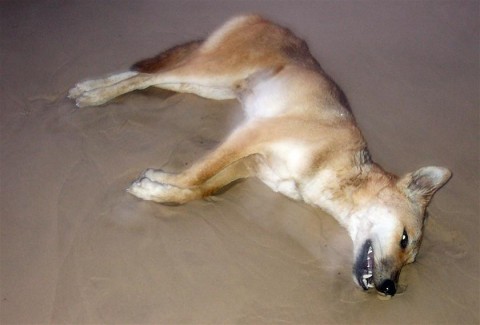 Starved dingo pup found on Fraser Island
Photo by local resident Judy Daniel, 2010
[Source: ^http://www.abc.net.au/news/stories/2010/03/30/2859757.htm] Starved dingo pup found on Fraser Island
Photo by local resident Judy Daniel, 2010
[Source: ^http://www.abc.net.au/news/stories/2010/03/30/2859757.htm]
.
.
Further Reading:
.
.
The Australian Dingo (or ‘Warrigal’) – a species deserving protection
.
[1] Fraser Island (UNESCO World Heritage) website, ^ http://whc.unesco.org/en/list/630
[2] ‘ Dingo protected in Victoria‘,20081024,
^http://www.abc.net.au/news/stories/2008/10/24/2400546.htm
.
.
Dingos are wild native animals
.
[3] ‘ Girl, 3, bitten by dingo at Fraser Island‘, ^ girl-3-mauled-by-dingo-at-fraser-island
[4] ‘ Dingo attacks child on Fraser Island‘, 20090807, ^ dingo-attacks-child-on-fraser-island
[5] ‘ Dingo attacks Fraser Island tourist‘, 20110121, ^dingo-attacks-fraser-island-tourist
[6] ‘ Dingo attacks tourist on Fraser Island‘, ^ dingo-attacks-tourist-on-fraser-island
[7] Lindy Chamberlain-Creighton website, ^ http://www.lindychamberlain.com/content/home
[8] ‘ Dingo attacks in Australia‘, ^ http://en.wikipedia.org/wiki/Dingo_attacks_in_Australia
[9] ‘ Dingo ‘superpack’ roams Fraser Island‘, ^ http://www.uq.edu.au/news/?article=5856
[10] ‘ Fears tourists’ dingo interaction threatens camping‘, Kallee Buchanan 20100316, ABC News,
^http://www.abc.net.au/news/stories/2010/03/16/2846964.htm
.
.
Saving Fraser Island Dingos
.
[11] ‘ Dingo enthusiast Jennifer Parkhurst fined $40k for feeding animals on Fraser Island‘,
Kristin Shorten, The Courier-Mail, Brisbane, 20101104, ^woman-fined-40k-for-feeding-dingoes
^
[12] ‘ I’m shattered, says dingo raid protester‘, 20090907, The Noosa Journal, Australia,
^http://animals-in-the-news.blogspot.com/2009/09/inval-overheid-in-woning-fraser-island.html
[13] ‘ Battle over the fate of Fraser Island’s dingoes‘, 20110108, Sydney Morning Herald,
^ battle-over-the-fate-of-fraser-islands-dingoes
[14] ‘ Dingo Management‘, ^ http://www.derm.qld.gov.au/parks/fraser/fraser-island-dingoes.html
[15] ‘ Fraser Island dingoes face extinction‘, Glenis Green, The Courier-Mail (newspaper), Brisbane, 20090523,
^ fraser-island-dingoes-face-extinction
[16] Fraser Island Footprints, ^ http://www.fraserislandfootprints.com/wp/?page_id=713
[17] Fraser Island Dingos Organisation (FIDO) website, ^ http://www.fido.org.au/
[18] ‘ A Draft Dingo Management Strategy for Fraser Island‘, FIDO website,
^http://www.fido.org.au/DingoManagement.html
[19] ‘Values of Fraser Island Tourism‘, FIDO website,
^http://www.fido.org.au/values-of-fraser-tourism.html
[20] Fraser Island Management Committee,
^http://www.tonycharters.com/heritage.html#CampingFraser
[21] ‘ Nomination of the Dingo as a threatened species‘, 2001, Australian Wildlife Protection Council,
^http://www.awpc.org.au/other_fauna/dingo1.htm
[22] ‘ Tourism operators criticise LNP Fraser Island plan‘, Kallee Buchanan, ABC TV News, 20100902,
^http://www.abc.net.au/news/stories/2010/09/02/3000360.htm
[23] ‘ Saving our wildlife from urban sprawl‘, 20101224, EcoNews.org.au,
^http://econews.org.au/2010/12/saving-our-wildlife-from-urban-sprawl/
[24] Fraser Island, ^ http://widebaygreens.org/fraser-island/
.
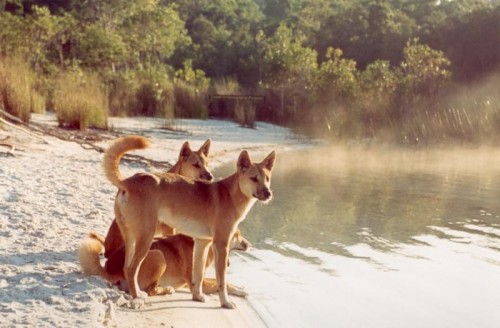
Wild dingos on Fraser Island
..deserve a healthy viable ecosystem, deserve to be left alone.
[Source: ^http://ozmagic2.homestead.com/dingo.html]
.
– end of article –
Tags: Azaria Lesson, dingo attacks, dingo ecology, dingo extinction risk, dingo persecution, dingos and children don't mix, Fraser Island dingo, Fraser Island tourism, Louise Parkhurst, pure dingo, The Fraser Island (Great Sandy Region), warrigal, World Heritage Fraser Island
Posted in Dingoes, Threats from Poaching and Poisoning, Threats from Tourism and Recreation | 1 Comment »
Add this post to Del.icio.us - Digg
Tuesday, April 26th, 2011
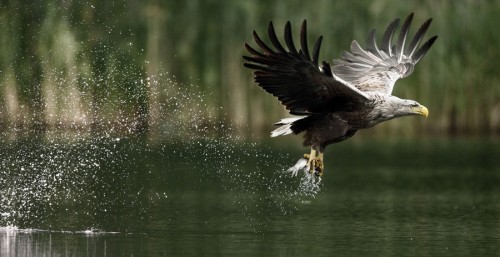 White-tailed Sea Eagle (Haliaeetus albicilla)
© Photo Terry Pickford
^http://raptorpolitics.org.uk/?p=502 (click photo to enlarge)
. White-tailed Sea Eagle (Haliaeetus albicilla)
© Photo Terry Pickford
^http://raptorpolitics.org.uk/?p=502 (click photo to enlarge)
.
.
‘Britain’s largest bird of prey, the white-tailed eagle or sea eagle, is a magnificent, if rare, sight in the wilder reaches of western Scotland.
This massive bird, the world’s fourth largest eagle, with a wingspan stretching 8 feet across, became extinct in Britain in 1918.
Sea eagles were wiped out in Britain due to excessive hunting and egg collection. The last native pair reproduced in 1916, and then there were no more. They were Britain’s largest bird of prey. In 1975 about 82 of the white-tailed eagles were reintroduced from other countries to the island of Rum, a small island off the coast of Scotland. The current human population is about 20, so the eagles should be relatively safe from poaching. Even though Rum is sparsely populated, the new eagles donated by Norway were released in a secret location.
Because of the reintroduction program and various conservation efforts, there are now 52 breeding pairs of the endangered eagles in Scotland. This year these adult eagles have produced about 46 hatchlings, which is a record for reproducing. Depending on the need, about twenty chicks each year are also being brought from Norway.
“I have no doubt that the successful reintroduction of this magnificent bird can continue, and along with the East Coast Sea Eagle Project, ensures that this species can establish territories right across Scotland, restoring a strong Scotland-wide population,” said Environment Minister Roseanna Cunningham. (Source: BBC) Read more: ^http://www.care2.com/greenliving/eagle-population-increasing-in-scotland.html#ixzz1Kbn4PYLe
.
Laws were changed during the 1950’s, which helped pave the way for two early attempts at reintroduction in Scotland. A full-scale reintroduction programme got underway on the island of Rum off the west coast of Scotland in 1975 with 82 birds taken from Norway.
The birds were released over a ten-year period and the first breeding success was recorded in 1985. A further 58 young Norwegian eagles were released onto the Scottish mainland and the first of these began to breed in 1998. In 2004, the population is thought to consist of around 80-90 individuals residing in 26 different territories. With the reintroduction programme now complete, Scottish sea eagles are entirely reliant upon Scottish bred young to continue the population. Sea eagles can now be seen on Mull, Skye and passing over many of the other western isles, although it is still a rarity.
Despite its protected status, sea eagles are still persecuted in Scotland. David Sexton, a The white-tailed eagle – also known as the sea eagle or white-tailed sea eagle – is a huge bird with broad wings up to 245 cm (over 8 feet) wide. White-tailed eagles became extinct in Britain in the early 1900s and despite a lengthy re-introduction scheme, their numbers in Scotland are still very low. The work to reintroduce the species has been hampered by the theft of eggs. This has led to local initiatives, such as Mull Eagle Watch, to help protect eagle nests.
[Source: Wildlife Scotland, ^http://wildlife.visitscotland.com/sitewide/featurerepos/sea_eagle/]
.
.
.
Habitat
The small population of white-tailed eagle in Britain is found only in the highlands and islands of the west of Scotland. Scottish white-tailed eagles prefer sheltered lochs or sea lochs rather than exposed coastal sites. They also prefer to nest in trees rather than on cliffs. On average, their territories range from 30 – 70 km2, but much larger territories are possible depending on the availability of prey. In Britain, white-tailed eagles are non-migratory. Breeding adults stay close to their breeding territory throughout the year. Non-breeding birds may range quite widely to find sufficient food.
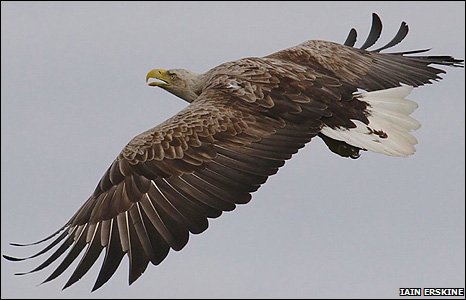 White-tailed Sea Eagle
^http://news.bbc.co.uk/2/hi/uk_news/scotland/glasgow_and_west/8465271.stm
White-tailed Sea Eagle
^http://news.bbc.co.uk/2/hi/uk_news/scotland/glasgow_and_west/8465271.stm
.
.
Threats
White-tailed eagles have no natural predators in Britain. The only threat to the bird’s continued re-colonisation in Scotland is from human activity, by poisoning or stealing eggs, and from degradation of habitat and food resources.
Royal Society for the protection of birds (RSPB) officer based on the Island of Mull explains:
.
“An adult was poisoned in the Highlands in 2003. Its mate died the same way in 2002, so there are still problems for them. Egg collecting is still a threat but local community watches and the police operation against nest robbers – Operation Easter – successfully kept it at bay in 2003.”
.
In total five birds have been killed since the reintroductions began.
.
[Source: ^http://www.forestry.gov.uk/forestry/white-tailedeagle]
‘The last recorded native white-tailed eagle in Britain was a rare albino (all-white) eagle that was shot in Shetland in 1917.’
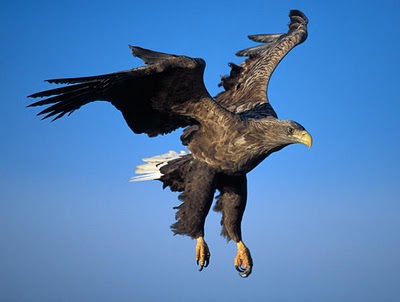 White-tailed Sea Eagle
[Source: ^http://bishopstownhc.blogspot.com/2010/01/bhc-members-spot-white-tailed-sea-eagle.html]
White-tailed Sea Eagle
[Source: ^http://bishopstownhc.blogspot.com/2010/01/bhc-members-spot-white-tailed-sea-eagle.html]
.
.
Sea eagles given more protection
[BBC, 23 March 11, ^http://www.bbc.co.uk/news/mobile/uk-scotland-12828674]
.
‘Sea eagles are to be given further protection in a new three-year scheme.
The £80,000 project involves Scottish Natural Heritage (SNH) working with farmers and crofters to help the birds throughout the areas where they breed.
Scotland’s sea eagle population has reached a record high since the birds were re-introduced on the Isle of Rum 36 years ago. But they are still considered to be rare with just 52 adult breeding pairs across the country.
Sea eagles lay up to three eggs in March with chicks leaving the nest in late July or August.
SNH will help to protect the birds, which usually nest in trees.
Stuart Housden, director of RSPB Scotland, said: “We are really pleased to have been involved in the development of workable measures that help support the conservation and management of these magnificent birds.”
The scheme will focus on agreements with farmers and crofters as well as promoting the birds potential for tourism.
Jonnie Hall, head of rural policy for NFU Scotland, said: “The aims and measures of the new scheme clearly reflect the inter-dependence of conservation and farming interests.”
An advisory panel will be set up to guide SNH on the key priorities. It hopes the scheme will be running by late spring or early summer.‘
.
.

White-tailed Sea Eagle
...
.
.
The Golden Eagle
.

 The Golden Eagle (Aquila chrysaetos)
^http://tohatchacrow.blogspot.com/2010/12/irish-farmers-suspected-in-another.html The Golden Eagle (Aquila chrysaetos)
^http://tohatchacrow.blogspot.com/2010/12/irish-farmers-suspected-in-another.html
.
.
.
ALMA is dead – POISONED – 30th July 2009
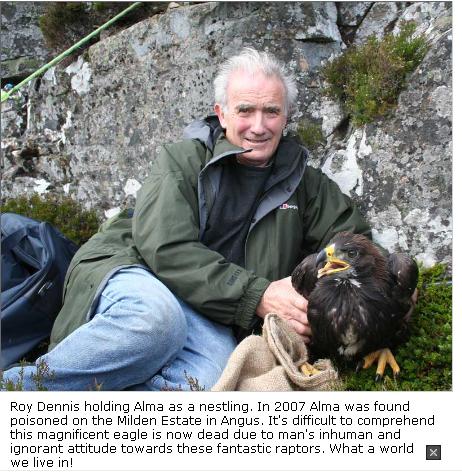
“I am truly appalled that yet another golden eagle has been illegally killed in Scotland – the second this summer.”
~ Scotland’s Environment Minister Roseanna Cunningham.
[^Read More]
“Another depressing example of the arrogant and outmoded attitude of some estate owners and their employees who treat the law with contempt, and break it with impunity. Their belief that land ownership gives them the right to use or abuse it as they see fit, and their dependency on the protection of ‘sport’ as a business, must be challenged.
Of course, the nature and remoteness of these businesses make them impossible to police effectively; but all the more reason to hand out exemplary sentences, including jail, when case are proven – not only to the keeper, but to the landlord.”
~ Alistair, 20090801.
.
.
.
Further Reading:
.
[1] Re-Introducing the White Tailed Eagle To Scotland, ^http://www.holidayscotland.org/re-introducing-the-white-tailed-eagle-to-scotland/
[2] Second Golden eagle found dead Poisoned in Scotland this year (2009), ^ http://raptorpolitics.org.uk/?p=502
[3] White-tailed Eagle Comeback Scheme for Scotland, ^ http://www.birdguides.com/webzine/article.asp?a=1045
[4] Secret release of 19 sea eagles in Scotland, ^ http://www.bbc.co.uk/news/uk-scotland-edinburgh-east-fife-11023724
[5] Young Sea Eagle numbers soaring in Scotland, ^ http://www.bbc.co.uk/news/uk-scotland-highlands-islands-11686816
[6] Sea eagles thriving on Isle of Mull, ^ http://news.bbc.co.uk/2/hi/uk_news/scotland/glasgow_and_west/8465271.stm
[7] Wikipedia ^ http://en.wikipedia.org/wiki/White-tailed_Eagle
[8] New Golden Eagle viewing scheme launched in Scotland, ^ http://www.wildlifeextra.com/go/news/golden-eagles_scotland.html
[9] The Golden Eagle Trust Ltd ^ http://www.goldeneagle.ie/
[10] Wikipedia ^ http://en.wikipedia.org/wiki/Golden_Eagle
(above websites accessed 20110426)
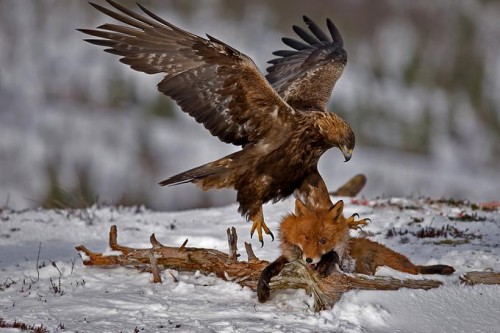 Golden Eagle
© Photo by Tom Elton
^http://naturfototomelton.blogspot.com/ Golden Eagle
© Photo by Tom Elton
^http://naturfototomelton.blogspot.com/
.
[end of article]
White-tailed Eagle
Tags: egg poaching, golden eagle, Isle of Rum, NFU Scotland, raptor persecution, Royal Society for the Protection of Birds, RSPB Scotland, Scottish Natural Heritage, Scottsh farmers poisoning eagles, sea eagle, Threats from Farming, white-tailed eagle, wildlife crime
Posted in 34 Wildlife Conservation!, Threats from Deforestation, Threats from Farming, Threats from Poaching and Poisoning | No Comments »
Add this post to Del.icio.us - Digg
Wednesday, April 13th, 2011
April 13th, 2011
The New South Wales Liberal Party has safely held the State electoral seat of Terrigal on the New South Wales Central Coast under its local party politician Chris Hartcher since 1988. In the March 2011 NSW election, Hartcher increased his margin by 15.9%, enough to run riot with a Liberal wish list.
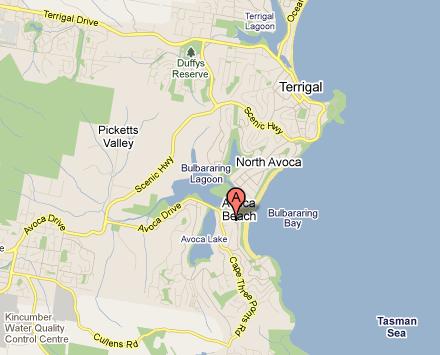
Bulbararing Bay (Avoca Beach)
New South Wales, Australian east coast.
.
.
‘HMAS Adelaide’ scuttled off Avoca Beach today
[Source: No Ship Group, Wednesday 13th April 2011]
.
‘On the Liberal wish list has been dumping HMAS Adelaide in the clean waters off Avoca Beach (Bulbararing Bay) , which lies within the Terrigal electorate.
Today the NSW Liberal Party leader Barry O’Farrell, fresh in power, has fast tracked the scuttling of a scrap Navy warship off the coast of North Avoca Beach.

The Royal Australian Navy has conveniently saved money by sinking its scrap warship, HMAS Adelaide, off Avoca Beach. It is no different an environmental blight than all the sunk warships still polluting the Pacific after World War II. Obviously Navy culture harks to 20th Century habits and until local resident action group, No Ship Action Group, took legal action the Navy irresponsibly was happy to conveniently leave all the toxic polychlorinated biphenyls aboard for the scuttling.
[Read more about the health effects of ^polychlorinated biphenyls].
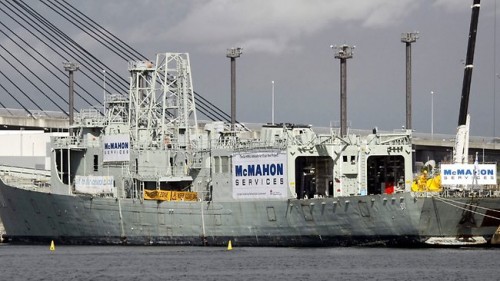 HMAS Adelaide (Navy Frigate)
. HMAS Adelaide (Navy Frigate)
.
‘On March 27 the State Government arranged a party to dump this “clean” warship in our bay without proper community consultation or an Environmental Impact Statement. A community had to raise $70 000 to obtain the truth and they have now been ordered to remove additional toxic materials at a cost of over a million dollars. They have already admitted that much of this toxic material will remain on the vessel and our request for transparent scrutiny of the completed work has been denied.’
.

.
.
So the cost of the scuttling has been estimated to cost Australian taxpayers up to $8.5 million! What does the Navy care? Costs don’t seem to matter to the Navy, let alone environmental costs or community costs.
What does Chris Hartcher care about the impacts of dumping a scrap metal wreck to the values of local traditional owners, or to local marine life, to migrating humpback whales, to public health, to surf patterns,to sand drift or to beach erosion? None of them has enough votes, which is all that counts in party politics. Co-incidental that senior members of the Central Coast Artificial Reef Project, driving this scuttling project are ex-Navy divers.
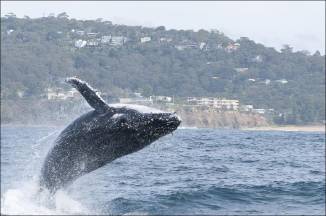 Humpback whale off Avoca Beach Humpback whale off Avoca Beach
.
The No Ship Action Group has highlighted comparable problems from the Adelaide’s sister ship, ex-HMAS Canberra, which was scuttled 2.3km off Ocean Grove, Victoria, in 2009.
Instead, the now promoted ‘Minister for the Central Coast’ Chris Hartcher said the wreck would generate millions of dollars in tourism and follow-on revenue for the coast’s economy.
“This will deliver significant recreational, tourism and economic benefits to the region, as well as educational and scientific research opportunities,” he said.
[Source: HMAS Adelaide sunk off Avoca Beach in NSW by Vince Morello 13th April 2011, AAP, ^http://news.smh.com.au/breaking-news-national/hmas-adelaide-sunk-off-avoca-beach-in-nsw-20110413-1dddv.html ]
Shame on the Navy, (as if it hasn’t enough shame already) for dumping its unwanted scrap on Australia’s coastline. Shame on MP Chris Hartcher and on Premier Barry O’Farrell. Dumping toxic ships in the ocean is an ‘archaic, reckless and wasteful act‘.
The so-called artificial reef will benefit selfish exploitist divers like the very vocal Terrigal Dive Centre.
.
.

‘HMAS Adelaide – The Only Thing Sinking on the Coast is Labor’s Resolve’
Tuesday, 09 June 2009
Shadow Minister for the Central Coast, Chris Hartcher, today called on Minister for the Central Coast, John Della Bosca and Member for Robertson, Belinda Neal, to get their act together and deliver the comparatively small amount of funding needed to bring the HMAS Adelaide to the Central Coast.
“This is a major project for the Central Coast. It has the potential to generate jobs and serious tourist dollars. I just can’t understand why the Labor Party have lost interest.
“This is one of the biggest issues facing local members, State and Federal but we’ve had nothing but eerie silence from Labor Members.
“Grant McBride mumbled some sorry excuse about bureaucracy but the reality is that he has the ear of the Premier. He’s right there in Nathan Rees’ party room. All he has to do is stick up his hand or pick up the phone.
“John Della Bosca is a Minister in the NSW Government – he helps hold the purse-strings. He could write the cheque today if he wanted to.
“And Belinda Neal has the ear of the Prime Minister – the man who stood by her through the Iguanagate scandal. Why won’t she just pick up the phone and ask for another favour?
“Coast residents shouldn’t be fooled – each and every Labor Member on the Central Coast is a mere phone call away from the money required to sink the Adelaide.
“But as usual, the Labor Party is full of excuses.
“It was a bureaucratic bungle, it was a mistake or they can’t find the funding.
“It’s all a bit ridiculous.
“Federal Labor and State Labor are under the same roof – why can’t they just get it together and cough up the cash?
“The State Labor Government has failed the Central Coast.
“The Federal Labor Government has failed the Central Coast.
“My message to each and every Labor MP on the Coast is a simple one; stand up against your own party’s incompetence and give us our artificial reef.
“The only thing sinking on the Central Coast at the moment is the Labor Members’ resolve.”
.
[Source: ^ http://www.chrishartcher.com/news_and_events/media_releases/hmas_adelaide_-_the_only_thing_sinking_on_the_coast_is_labors_resolve.html, accessed 13th April 2011.]
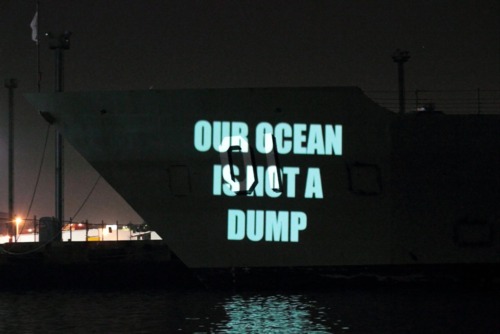
.
Lest We Forget the Local Protest
.
‘600 people join Avoca Beach protest against sinking ex-HMAS Adelaide’
[The Express Advocate, 8th March 2010, ^ http://express-advocate-gosford.whereilive.com.au/news/story/600-people-join-avoca-beach-protest-against-sinking-ex-hmas-adelaide/]
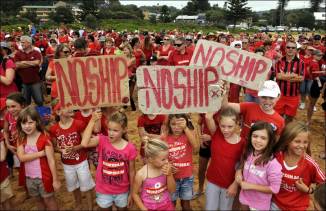
The golden sands of Avoca Beach turned to a sea of red Saturday morning when around 600 people turned up for a rally protesting the sinking of the ex-HMAS Adelaide.
Organisers had asked people to wear red as a sign of their opposition to the sinking of the ship 1.7km off Avoca Beach.
The concern that had been growing since residents discovered in January the ship would be scuttled off Avoca and not Terrigal culminated in Saturday’s rally where protesters danced and waved their hands to songs by Midnight Oil, the rock band formerly fronted by Peter Garrett, the environment minister who will sign off on the sea dumping, and cheered guest speakers who all spoke passionately about their environmental and lifestyle concerns.
Organised by the No Ship Action group, the rally was addressed by Dr Ian Charlton, a GP in the area and keen surfer, Quentin Riley, a long time Avoca Beach resident, Ben Smith an oceanographer and commercial pilot, Scott Forty, a doctor and dive enthusiast, Gary Whittaker, a builder, and Avoca Beach residents Kylie Hobin, Neil Robinson and Susan O’Connor.
“We all love Avoca Beach,’’ Mr Riley said.
“We are here to tell the truth about this situation. “We’re not just worried, we’re frightened, very frightened about the repercussions of the sinking of this ship.’’
Speakers spoke of the lack of consultation, the lack of an environmental impact statement (EIS), the lack of communication with the authorities organising the sinking, and the fear the ship will contain toxic materials including PCBs.
“If there has been an EIS, we would have been consulted 18 months ago,’’ Mr Riley said.
“We would have asked our questions then and we would have got answers. Around 4000 people never got the chance to comment or question the project.’’
Mr Smith, an Avoca Beach resident and commercial pilot, said he had grave concerns about the future of the beach and described the sinking as a ‘wanton act of vandalism’.
He said no other ship had been scuttled so close to shore.
“Stand up and be counted,’’ he said.
“This is our home and we don’t want that dam boat.’’
Mr Forty, a dive enthusiast, said most dive wrecks were located where they had met an unfortunate end, not placed in a pristine environment so close to shore.
“For a dive experience this is too good to be true, just a six minute boat ride from Terrigal and in only 30 metres of water,’’ he said.
“It will be like a Queensland theme park. “It should be scuttled further out and it would be a more interesting dive.
“Put it our further and it’s only a 20 minute ride, please rethink the site.’’
The two-hour rally finished up with the protesters lining up on the beach to spell out NO SHIP.
Lands Minister Tony Kelly said on Friday the scuttling was on schedule and would take place on March 27.
He said independent tests found no traces of PCBs on the vessel.
“I hope this now puts to bed unfounded claims being spread through the local community,’’ Mr Kelly said.
“All potential impacts have been considered including marine life, flora, fauna, water quality, swell conditions and sediment movement in the bay.
“The community can feel assured by these painstaking preparations and investigations.’’
.
.Common questions (from the HMAS Adelaide Reef website, before the scuttling):
.
1. Where is the Ex-HMAS ADELAIDE now?
The Ex-HMAS ADELAIDE is at the Sydney ports Corporation Berth No. 2 at Glebe Island on White Bay. It is undergoing final preparation for scuttling and its future as a dive site.
2. How is the site being designed for diving?
The Land & Property Management Authority (LPMA) has engaged the services of a team of designers who have been responsible for the design of every other military wreck around Australia. Assisting this team is a reference group which consists of representatives from local dive clubs, professional divers (such as the Navy, Police and Army divers), industry regulators such as Workcover and rescue personnel.
3. Who approves the environmental standard of preparation of the ship?
The ship will be prepared to the stringent environmental standards required by the Commonwealth Department of Sustainability, Environment, Water, Population and Communities (DSEWPC). They are responsible for approving the scuttling of the ship under the Environment Protection (Sea Dumping) Act 1981. You can also read our Environmental Fact Sheet about the Ex-HMAS Adelaide.
4. When and where will the Ex-HMAS ADELAIDE be sunk?
The scuttling of the Ex-HMAS ADELAIDE is scheduled to take place on Wednesday 13 April, so long as weather conditions are favourable. The vessel’s final resting place will be approximately 1.4km south of the Skillion at Terrigal and 1.8km off Avoca Beach in around 32m of water.
5. What will happen at this time?
On 11 April the Ex-HMAS ADELAIDE will be towed to the Central Coast. It will be escorted by police and other authorities and will have an exclusion zone in place. It will be anchored off Avoca Beach whilst final preparations are made such as cutting dive access holes above the water line. On the day of scuttling an exclusion zone of around 1000m will remain in place until after the Ex-HMAS ADELAIDE in scuttled and all safety checks have been completed.
6. What constitutes a successful scuttling?
The intention is for the Ex-HMAS Adelaide to be sunk in an upright position at the designated location and orientation, approximately ESE. Should the vessel not scuttle exactly as planned, this will not adversely affect its operation as a dive site and artificial reef. Some divers even suggest that it might be more interesting as a dive site if it is not perfectly upright.
For the scuttling process, an exclusion zone will be in place for the safety of spectators, and a spotter helicopter will check that there are no passing whales, dolphins etc.
7. Why are the weather conditions so important?
When the ship is towed out to be scuttled it will have no power or ability to move independently. It will also have many pre-cut panels in the hull above the water line which will become dive access holes once the panels are removed after arriving at the scuttling site. Calm weather conditions, little wind and low swell are required to safely take the ship out to sea and scuttle it.
In the event that weather conditions are not suitable to commence the tow from Sydney, towing will be postponed until Saturday 16 April, with the scuttling to take place on Monday 18 April, subject to favourable weather conditions.
Once the Ex-HMAS ADELAIDE is anchored off Avoca and planned scuttling is not possible due to unfavourable weather conditions, the scuttling will take place at the first available opportunity when weather conditions are suitable.
8. Where will the Ex-HMAS ADELAIDE be finally located?
The Ex-HMAS ADELAIDE will be located approximately 1.4km south of the Skillion at Terrigal and 1.8km off Avoca Beach in around 32m of water.
9. How many moorings will there be?
There will be six moorings placed around the ship. Two of these will be exclusively licensed to commercial operators, another two will be available for any commercial operator to book on a casual basis. The final two moorings will be available to recreational divers.
10. How will the dive site be managed?
A Crown reserve (the HMAS Adelaide Reserve) has been declared over the final resting place of the Ex-HMAS ADELAIDE. An agent will be engaged to market the opportunity to the dive and tourism industries, issue permits to dive the Ex-HMAS ADELAIDE and take bookings for moorings.
11. Will I have to pay to dive the Ex-HMAS ADELAIDE?
Yes. The ongoing management and maintenance of the dive site to ensure it remains a world class dive attraction will cost money. As such it is expected that a per dive fee will be collected to recover the cost of these activities. Pricing is yet to be determined.
12. How will I buy a ticket to dive?
A ticket to dive the Ex-HMAS ADELAIDE will be able to be purchased from the LPMA’s commercial agent. Before being issued with a permit all divers will be required to provide evidence that they have the necessary dive qualifications and agree to abide by a Code of Conduct whilst on the dive site.”
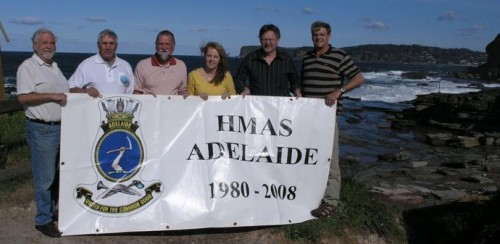 Central Coast Artificial Reef Project Committee Central Coast Artificial Reef Project Committee
The CCARP committee is comprised of members of Brisbane Water Aqualung Club, Terrigal Underwater Group, Terrigal Diving School.
CCARP was originally created with the aim of lobbying the Commonwealth and NSW governments for acquisition of the decommissioned destroyer HMAS Brisbane. For a number of years the Australian Federal Government has had a policy of ceding to the states its warships as they become surplus to requirements and are decommissioned.
.
~ ~
.
…’Selfishness is not living as one wishes to live, it is asking others to live as one wishes to live’.
~ Oscar Wilde
..when
 Blessing Ceremony by local Indigenous people of Bulbararing Bay in 2008
^http://www.5landswalk.com.au/avoca-beach
.
~ WE NEVER ‘CEDED‘ ! Blessing Ceremony by local Indigenous people of Bulbararing Bay in 2008
^http://www.5landswalk.com.au/avoca-beach
.
~ WE NEVER ‘CEDED‘ !
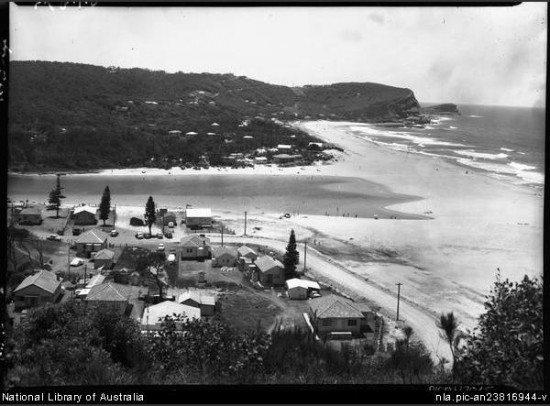 . .
‘Scuttling of warship will be a disaster’
[Source: Sydney Morning Herald, 20110412, ‘Scuttling of warship will be a disaster’, by Garry Trompf, Arcadia, Letters to the Editor, http://www.smh.com.au/national/letters/ , viewed 20110412.]
‘I am deeply concerned about the scuttling of HMAS Adelaide at Avoca (”Ombudsman sinks last bid to stop scuttling of frigate”, April 11, smh.com.au).
If the break-up of Adelaide’s sister ship, HMAS Canberra, is anything to go by, there will debris all over the beaches around Avoca within the next 18 months.
The navy’s destroyers which have previously been scuttled are all intact, but they are not constructed like frigates. The frigate HMAS Canberra has broken up after just 16 months. A New Zealand frigate lasted just six weeks before breaking into three and spreading debris all over nearby beaches.
The disintegration of HMAS Adelaide will also involve the dispersal of 23,000 square metres of lead paint and other dangerous contaminants in an area where migratory humpback whales (including calves) take shelter and where many families and children enjoy the beaches. It is a recipe for disaster.
Under the plan of management for the ex-HMAS Canberra, the dive site will be closed as a commercial site if the ship falls over or breaks up.
These issues are not mentioned in the review of environmental factors for the scuttling of HMAS Adelaide.
The NSW Ombudsman’s office has rightly asked for explanations on a range of issues. It has to be decided whether the state government has been complying with the orders of the Administrative Appeals Tribunal. The Premier should defer the sinking until the Ombudsman’s questions are answered.
I believe a reconsideration of the matter will reveal the utter lack of wisdom in allowing the vessel to be dumped in such environmentally sensitive waters.’
.
.
.
.
Naval history of ‘frigate dumping‘ on communities
.
The Royal Australian Navy has a history of dumping its friggin frigates on coastal communities. At 2 pm on Sunday, 4 October 2009, the Navy’s unwanted Guided Missile Frigate FFG02 HMAS Canberra was scuttled off the Victorian seaside town of Ocean Grove. Two years earlier, the Federal Government had committed $7 million of taxpayers money to prepare the ship for scuttling.
[Source: http://www.hmascanberra.com.au/sink-the-canberra.htm]
Just like the scuttling of ex-frigate HMAS Adelaide, the scuttling of ex-frigate HMAS Canberra was all so that local divers could have somewhere fun to play.
Seems a bunch of ex-Navy divers have come up with a novel way for the Navy to rid itself of old stock, while dive schools reap the promise of dive tourism revenue. But at whose expense?
Problem is that Victorian Artificial Reef Society and local divers may not get that chance to play, since the HMAS Canberra has been reported breaking up and is now deemed unsafe to dive on, and may never be. What is certain is that the Navy has dumped on Australia’s coastline. (Read article extract below: ‘EXCLUSIVE: HMAS Canberra breaking up‘).
Can Australian taxpayers expect to get their $7 million recompensed from the Nay from its botched HMAS Canberra scuttling? What chance is the $8.5 million from the HMAS Adelaide another botched scuttling? Couldn’t Australia’s Navy better spend the combined $15.5 million that it has scuttled, instead on meeting Australia’s important strategic Defence obligations?
In May 2007 the Navy was funded $52 million over four financial years for the continued surveillance of Australia’s northern approaches as part of Operation Resolute. $15.5 million represents about a third of that funding, which could have been better spent on more effective surveillance of Australia’s northern approaches.
[Sources: ^ http://www.navy.gov.au/Budget_boost_for_ADF, ^ http://www.navy.gov.au/Operation_Resolute]
.
Couldn’t Australia’s Navy be more responsible with its unwanted vessels by dismantling them and cost-recovering the parts for scrap/recycling?
.
.
.
EXCLUSIVE: HMAS Canberra breaking up
.
[Source: Ocean Grove Voice community newspaper, February 2011, ^ http://www.oceangrovevoice.com/2011/02/exclusive-hmas-canberra-breaking-up/]
.
‘PARKS Victoria has warned divers the ex-HMAS Canberra off the coast of Ocean Grove has begun to break up and could be dangerous, writes Carly Helweg.
.
The Victorian Government’s website reports the helicopter hanger on the port side of the ex-HMAS Canberra, scuttled in October 2009, “has separated from the main super structure.”
.
A statement issued on the Parks Victoria website said, “As a result the frames and plating on the port side are moving 30mm vertically and 150mm horizontally which may pose a hazard to divers in this area as the structure may move unexpectedly.”
“There are a large number of loose items in the lower deck and mid-ships areas of the vessel including lockers, cabinets, panelling and ducting.”
It warns, “It is strongly recommended that recreational divers stay away from these areas of the vessel to avoid the risk of personal injury.”
.
A NSW environmentalist group has used HMAS Canberra as an example in protesting the scuttling of sister ship, HMAS Adelaide, off Avoca Beach on the Central Coast.
According to an article in the Sydney Morning Herald on February 9, the No Ship Action Group at Avoca spokeswoman, Michelle Meares, said the Canberra has already tipped from an angle of 3 degrees to an angle of 22 degrees.
It is claimed if the Canberra leans over a certain angle it will fall, making it unusable as a dive site.
“When it gets to 27 or 30 degrees, it will likely tip over and not be able to be used as a diving wreck,” Ms Meares said to the Herald.
The Herald also reported, “according to Parks Victoria source, fiberglass insulation, foam insulation from wall and ceiling cavities, panelling and other debris is floating in the bay or has washed onto the beach.”
.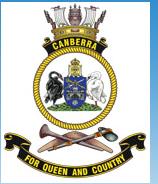
.
.
Further Reading:
.
[1] No Ship Action Group, ^ http://noship.com.au/
[2] HMAS Adelaide Artificial Reef website, ^ http://www.hmasadelaide.com/
[3] Search the Internet on the subject of ‘ artificial reefs impacts‘
[4] Now the Navy wants to sink another old ship at Jervis Bay…’ Sinking the HMAS Manoora in Jervis Bay‘, 201108 “Shoalhaven City Council has confirmed it’s in principle support on a proposal for the sinking of the HMAS Manoora as a dive site in Jervis Bay at last night’s extraordinary Council meeting.”
[Read Shoalhaven Council Report]
[Read http://sites.google.com/site/whathappenedatavoca/ex-hmas-manoora]
.
.– end of article –
Tags: Barry O'Farrell, Bulbararing Bay, CCARP, Central Coast Artifical Reef Project, Chris Hartcher, frigate dumping, HMAS Adelaide scuttling, HMAS Canberra, humpback whales, McMahon Services, No Ship at Avoca, noship.com.au, Operation Resolute, Parks Victoria, polychlorinated biphenyls, Royal Australian Navy, Sinking the HMAS Manoora in Jervis Bay, Terrigal Dive Centre, Terrigal Electorate, Victorian Artificial Reef Society
Posted in Threats from Dumping, Threats from Pollution | 3 Comments »
Add this post to Del.icio.us - Digg
Friday, April 8th, 2011
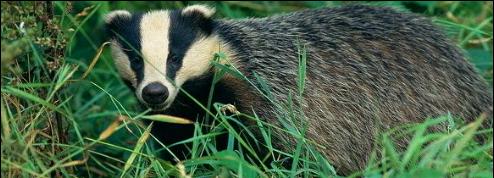 Native Badger (Meles meles)
Reilly and Gole Woods Nature Reserve
(Northern Ireland Environment Agency) Native Badger (Meles meles)
Reilly and Gole Woods Nature Reserve
(Northern Ireland Environment Agency)
.
…Native badgers are under threat across the United Kingdom from misguided State-sanctioned poaching.
.
“People come–they stay for a while, they flourish, they build–and they go.
It is their way.
But we remain.
There were badgers here, I’ve been told, long before that same city ever came to be.
And now there are badgers here again.
We are an enduring lot, and we may move out for a time, but we wait, and are patient, and back we come.
And so it will ever be.“
.
~ Kenneth Grahame, The Wind in the Willows, Chapter 4.
.
.
The Badger – a native to Britain
.
Most people in Britain only know of badgers as road kill mess from their cars and trucks as they drive fast along country roads. Most people in Britain live in the warmth, convenience and security of an urban environment closely in their urban social groups.
Badgers live closely in their own social groups in the warmth, convenience and security of their underground ‘setts‘. Badgers live a whole world away from people, or would if they could – they have become nocturnal in places with high human populations. Over the centuries, as human numbers have exploded across Britain, people have spread further and further taking over and destroying wildlife native habitats, including the world of the native badger.
Few people in Britain will know much about the badger and its ecology, save of course wildlife ecologists, zoologists and the growing number of dedicated ‘badger watchers‘.
Badgers remain one the largest wild animals left across the British Isles. They are beautiful animals. They are native and deserve human respect.
.
.
Says wildlife photographer from Lancashire, (Michael S):
“As a wildlife photographer, I’m lucky enough to spend a good portion of my time observing the wildlife of this country. Nothing – and I mean NOTHING – is as magical to me as the moment, after much silent waiting around in cold, damp woodland, that the first badger tentatively emerges from its sett, shortly followed by the rest of the family (presumably once the “all clear” has been given). I’ve often been so transfixed just watching them interact and play that I forget to take photos.”
[Source: BBC website, http://www.bbc.co.uk/news/magazine-11380921 [Viewed 20110318]
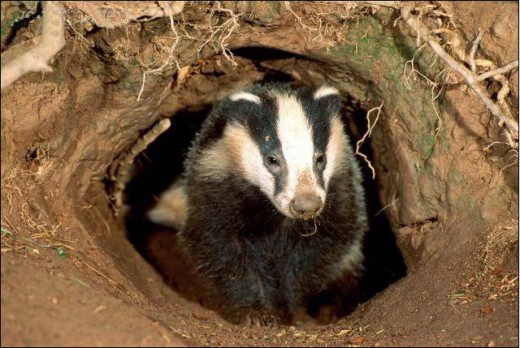
.
.
‘The European Badger (Meles meles) belongs to the family of mammals known as Mustelidae (possessing musk glands), otherwise known as the weasel family and includes the otter, stoat, polecat, ferret and pine marten. The badger is indigenous to most of Europe including the British Isles, with the largest abundance found within southern England.
‘The name ‘badger‘ is believed to come from the French word ‘becheur‘, meaning digger. Across Britain, badgers occupy a large range of habitat types and they are often found in what’s left of Britain’s native woods and copses, as well as in scrubs, hedgerows, quarries, moorlands, open fields and even in housing estates as the developers encroach on pastoral areas. They are however more abundant in areas where a mosaic of features are present such as deciduous woodland, pasture and arable habitat types. Remember that the badgers and their native habitat existed before the property developers.
Badgers live in setts, a network of underground tunnels, which they dig using their strong claws. Badger density increases with hilliness and a survey undertaken by the Mammal Society has found that 92% of setts in Britain were dug into slopes. Badgers prefer slopes for a variety of reasons. Firstly slopes help the excavation of soil, which can spill down the slope as it is dug. Sloping land is also well drained and more likely to be warm and dry. In colder climates badgers can easily dig to a depth with is frost proof.
As social group has about five badgers in winter and is typically headed by a dominant male and female. Male badgers patrol their territory boundary during the early spring breeding season (February – March) and mark the borders of the territory with dung. If a stray boar (head male) from another colony is encountered the ensuing fight can be particularly fierce.
Although badgers are members of the order carnivore, they are in fact foraging ominvores, meaning they eat a wide range of plants and animals. This has aided their adaptability, as humans have destroyed the natural landscape. Badgers have a varied diet depending on what food available and on the time of year. A badger’s diet mainly consists of earthworms and a large boar can eat as many as 200 earthworms in a single night. Their diet is supplemented with insects, birds, small mamals, fruits and berries, cereals , reptiles and amphibians.
[Source: The Badger Trust, November 2008]
.
.
Badger – a history of human persecution
.
Badgers have an excellent sense of smell and can find human scent particularly disturbing. Badgers have an elusive nature, inculated from centuries of human persecution.
In England prior to the 19th Century, the badger is believed to have had a wide distribution, but heavy persecution in the 19th Century caused numbers to drop dramatically and by the end of the 19th Century badgers were considered rare. Badgers were largely poisoned, trapped and shot by game keepers and farmers who mistakenly saw the badger as a threat to livestock. Between 1960 and 1972 numabers also were in decline due to increased road construction and vehicle numbers as well as trains causing escallating roadkill of badgers aand other wildlife. In addition, badger persecution has extended to gassing of badger setts, shooting and increased overuse by farmers of pesticides causing badgers to be poisoned and causing reduction in fertility rates.
The passing of the Badger Act 1973 (and amendments in 1981, 1991, and 1992) has helped badger number to recover and today across Britain there are an estimated population of 300,000.
.
Badger Baiting
.
‘Badgers were also cruelly persecuted through the 18th Century by the wicked blood practice of ‘badger baiting‘ . Badger baiting was outlawed in the United Kingdom as early as 1835, with the introduction of the Cruelty to Animals Act and the Protection of Animals Act 1911. Badger Baiting was made illegal in 1835 and is currently an offence under the but it has never died out. Sadly, it is the badger’s tenacity, its apparent ability to absorb almost any punishment and still go on fighting, which has made it a target for people who get their kicks from inflicting cruelty upon animals, even today.
Every year, hundreds of badgers meet a horrific death in the name of ‘sport’ in the UK at the hands of terriermen. Many of those who have been caught digging into badger setts have used the excuse that they were after foxes – and many have escaped prosecution by so doing. More than 10,000 are caught, tortured and killed in the UK each year by huntsmen with terriers – with almost a third of these illegal acts being carried out in Wales. Alarmingly, this figure is rising constantly. Terry Spamer, a former RSPCA inspector, believes that there are around 2,000 people involved in badger baiting currently. However, only around three people are caught and convicted of badger baiting each year, while the majority carry on breaking the law.
Small terriers, such as Lakelands, Patterdales, sometimes Jack Russells or a cross-breed are sent down into a badger sett to locate a badger and hold it at bay. The men then dig their way down to their quarry and drag the badger out of the sett. Many diggers attach a radio transmitter to the dog’s collar before sending it below ground then all they have to do is use a radio receiver/locater to determine the exact location of the dog.
There are essentially two types of badger baiters. The first who do it just for the pleasure of killing the badger on the spot and no money is involved. If it’s lucky the badger will be shot but usually the men will set their snarling terriers on the badger and watch it suffer a long and agonising death stabbing it with shovels for good measure. At times, the dogs and the badgers may die when the sett collapses and suffocates them.
The second type of badger baiting involves gambling where large sums of money can change hands. The badger is dug out of the sett in the manner described above and then it is put in a bag and taken away to be baited later on. The badger is taken somewhere quiet for example a barn, shed or cellar and placed into a makeshift arena, a ring or pit, from which it cannot escape. Dogs are then set upon it. Even if the badger is lucky enough to get the better of one dog, the owner may hit or otherwise injure the badger in order to ‘protect his pet’. Ultimately, no matter how well it tries to defend itself, the badger’s fate is sealed. The badger, through injury and exhaustion, will not be able fight any longer. Its back legs are held by a chain to prevent escape. The animals multilated head, minus nose and lower jaw, finished up mounted on a plaque. The baiters will then kill the badger usually by clubbing or shooting it. Gambling is always involved and a winning dog’s value will rise – along with the price of its puppies. An anonymous letter received by Badger Watch & Rescue Dyfed states that badgers are being caught and sold for about £500 for baiting.
 Badger Baiting, London, circa 1824
[Source: Henry Thomas Alken, this image is free in the public domain due to its age,
Wikipedia, ^http://en.wikipedia.org/wiki/File:Badger-baiting3.jpg] Badger Baiting, London, circa 1824
[Source: Henry Thomas Alken, this image is free in the public domain due to its age,
Wikipedia, ^http://en.wikipedia.org/wiki/File:Badger-baiting3.jpg]
.
Badgers are shy and peaceful animals and not normally aggressive, but will defend themselves if cornered or provoked. A badger has great strength and a blow from one of its vicious claws can do serious harm. Many dogs seriously injured during badger digging and baiting go untreated as their owners are more concerned vets will become suspicious of the owner’s illegal activity.’
(Read More)
.
Badger Hunting
.
‘People kill more badgers than predators and natural causes. In most of the countries where badgers live, they are hunted in great numbers for several reasons. Several thousands of badgers are targeted for their fur, meat or just a cruel ‘sport’. In some countries like Germany, USA and Canada, the hair of badgers are used in shaving and painting brushes. In Britain, Badgers are legislatively protected. However, killing badgers in Britain rather continues secretly.
Badgers are hunted in several ways. Through illegal and cruel methods, people dig out badgers from their setts. In several cases, badgers are also snared, shot or poisoned to death. Very often, badgers also accidentally get trapped in snares set up to catch foxes. Quite a many times, the snares are left unchecked for hours or days and the badgers caught up in them are left to their cruel fate of suffering a long agonizing period of capture, starvation, and dehydration, eventually facing a horrible death.

Urban sprawl and intensive agriculture are two main threats to the life and population of badgers. Badgers are creatures of rather a set habitual pattern and are not good in adapting to any change. Under disturbances from people or developments, badgers are forced to quit their habitat and move on or just die out in a helpless state. Quite unknown to people, badgers can also come to the gardens, cultivations and parks of the suburban area in search of food.
Badger hunting in the name of fun or sport or under the belief that they damage livestock has seriously devastated the badger population in some areas like South Yorkshire. In certain regions like Essex, agricultural intensification has resulted in the decline of badger population.
Some people use modern technology to hunt badgers. Night vision equipments enable the poachers to trace the poor animals in the dark, at the same time evading from the eyes of gamekeepers and police personnel. The other technology used in hunting is lighting. In this method, the criminals carry a high-intensity searchlight and locate the animals. Once the animals are disoriented at the sight of bright light, they either shoot the animals or capture them using hunting dogs.
There are also cases of poisoning the badgers, both accidentally and purposefully. Quite often when the poison is meant for killing other wilder life and pests, many poor badgers become unfortunate victims and die. Badger hunting is a serious offense. Unintentional killings of badgers can invite heavy fines and warnings, while intentional killings can lead to jail sentences.’
[Source: http://www.savethebadgers.co.uk/badger-hunting.shtml]
.
.
Badgers and British Law
.
Why are badgers protected?
.
Badgers and their setts are legally protected from intentional cruelty, such as badger-baiting, and from the results of lawful human activities, such as building developments. The legislation, mainly the Protection of Badgers Act 1992 (the 1992 Act), has provided a useful tool in deterring the abuse of badgers and in prosecuting those who continue to break the law.
.
However, it is a sad fact that many thousands of badgers are still killed illegally each year, and the incidents appear to be increasing. Also, due to the nature of the crimes, there are relatively few successful prosecutions.
These notes are intended to provide some background to the law relating to badgers. However, the issue is complex and more detailed information can be obtained by contacting Badger Trust
.
Threats to badgers
.
Badgers in the UK are threatened by both legal and illegal activities.
Legal activities, subject to compliance with conditions in the 1992 Act, include:
.
- Road and housing development;
- Forestry and agricultural operations; and
- Badger culling by the Department of Environment Food and Rural Affairs and the Welsh Assembly Government in relation to bovine TB in cattle;
.
Illegal threats to badgers include:
- Badger-digging and baiting
- Snaring
- Poisoning (including the misuse of pesticides)
- Lamping, and
- Sett interference
.
.Relevant legislation
.
The main legislation protecting badgers in England and Wales is the Protection of Badgers Act 1992 (the 1992 Act). Under the 1992 Act it is an offence to:
- wilfully kill, injure, take or attempt to kill, injure or take a badger;
- possess a dead badger or any part of a badger;
- cruelly ill-treat a badger;
- use badger tongs in the course of killing, taking or attempting to kill a badger;
- dig for a badger;
- sell or offer for sale or control any live badger;
- mark, tag or ring a badger; and
- interfere with a badger sett by:
- damaging a sett or any part thereof;
- destroying a sett;
- obstructing access to a sett;
- causing a dog to enter a sett; and
- disturbing a badger while occupying a sett.
.
The 1992 Act defines a badger sett as: “any structure or place which displays signs indicating current use by a badger”
.
.
DEFRA’s position on Bovine TB and British cattle as at 6 April 2011
.
[NOTE: This data has been extracted, rather than referenced as a link, due to the changeable habit of DEFRA changing its website. If DEFRA wishes to retain public access to its referenced documents, then members of the public ought to be able to access these freely from DEFRA’s website ].
DEFRA’s website (as at 6 April 2011): http://www.defra.gov.uk/food-farm/animals/diseases/tb/
.
‘Bovine tuberculosis (bTB) is an infectious disease of cattle. It is caused by the bacterium Mycobacterium bovis (M. bovis), which can also infect and cause TB in badgers, deer, goats, pigs, camelids (llamas and alpacas), dogs and cats, as well as many other mammals.
Bovine TB is a zoonotic disease, which means it can be transmitted from affected animals to people, causing a condition very similar to human TB. However, the risk of people contracting TB from cattle in Great Britain is currently considered very low.
This page aims to provide a comprehensive introduction to our work to tackle the disease.’ ~ DEFRA.
Latest news
- 31 March 2011 – Cattle testing positive for TB to be DNA tagged
- 28 March 2011: Bovine TB surveillance reports for Great Britain compiled by the Veterinary Laboratories Agency (VLA)
- 18 March 2011: Provisional TB statistics for Great Britain are now available for December 2010
- 28 February 2011: Bovine disease compensation payable during March 2011
- 31 December 2010: Statistics for TB in non-bovine species are now available
- 11 November 2010 – Defra launches new support service for TB affected farmers
- 8 November 2010 – the following material has been made public:
* Safety and efficacy data from the studies used to license the injectable badger vaccine, BadgerBCG
* Computer modelling comparing badger control strategies for reducing bovine TB in cattle in England.
To view this material, and supporting information, please see the Research section of this page
15 September 2010 – the following material has been published:
- Government’s approach to tackling bovine TB and consultation on a badger control policy (this consultation has now closed. We will be announcing a comprehensive and balanced TB Eradication Programme for England as soon as possible)
- Changes to cattle testing policies
- Review of the pre-movement testing policy in England and Wales – April 2006-March 2009
- Bovine TB and the use of PCR: Summary of 12 July meeting chaired by Defra’s Chief Scientific Advisor
.
Key facts and figures
- Bovine TB is a largely regional problem, concentrated in the West Midlands and South West of England.
- 91.9% of cattle herds in England were officially bTB-free on 31 December 2010.
- 24,899 cattle were slaughtered for bTB control in England in 2010 (compared with 25,557 in 2009).
- Government spend on bovine TB in 2009/10 was about £63 million in England.
- Monthly statistics are published
.
What is the case for government action?
Alongside maintaining vigilance over risks to public health, the main rationale for government intervention is to mitigate the economic impact of the disease on the farming industry and to meet EU legal requirements.
The original reason for government’s involvement in tackling the disease was to protect public health. Pasteurisation of cows’ milk, together with a comprehensive cattle testing/slaughter programme, and inspection of cattle carcases at slaughterhouses, have significantly reduced (to a very low level) the risks to human health.
Bovine TB is having a serious impact on many farm businesses and families, especially in the West and South West of England. Thousands of cattle are slaughtered each year at huge financial and emotional cost to farmers. The area of England affected by bovine TB has grown from isolated pockets in the late 1980s to cover large areas of the West and South West of England. The costs to the taxpayer are rising year by year and there is a strong case for early effective action to turn this around.
No single measure will be enough to tackle the disease on its own. We need to use every tool in the toolbox. There is a significant reservoir of infection in badgers and evidence suggests, without addressing the problem in the badger population, it will not be possible to eradicate bTB in cattle. Cattle measures will remain the foundation of our bTB eradication programme but we also need to deal with the disease in badgers. The farming industry, the veterinary profession and government need to work in partnership if we are to eradicate the disease.
Current situation and background
There has been a long-term (over 25 years) increasing trend in bTB incidence in cattle, driven by both cattle-to-cattle and badger-to-cattle transmission.
A wide range of measures is in place to tackle, and reduce further spread, of the disease, including:
- Regular cattle herd surveillance testing
- Slaughter of test positive ‘reactor’ cattle
- Herd movement restrictions on bTB breakdown herds
- Zero tolerance of overdue herd tests
- Use of additional, more sensitive diagnostic tests
- Pre-movement testing (paid for by farmers) of cattle from high risk herds
- Farmer advice, including husbandry guidance
.
Badgers and bovine TB
The Coalition has committed, as part of a package of measures, to developing affordable options for a carefully-managed and science-led policy of badger control in areas with high and persistent levels of bovine TB.
Defra has been looking at all the key relevant evidence, including published scientific evidence from the Randomised Badger Culling Trial (RBCT) and subsequent post-trial analyses, to draw up proposals, which have been published for public consultation.
The government’s proposal is to issue licences to farmers/landowners who wish to cull and/or vaccinate badgers at their own expense. These licences would be subject to strict licence criteria to ensure badger control is done effectively, humanely and with high regard for animal welfare.
We welcome your comments and responses to the consultation (our website also contains details of how to submit your response):
* Consultation documents
As part of Defra’s commitment to tackling the issue of bovine TB, government has invested in a significant research programme looking into the development of vaccines for both cattle and badgers.
* More information on vaccination
A Badger Vaccine Deployment Project (BVDP) is being funded by Defra to assess and maximise the viability of using injectable badger vaccine and to help us move towards the long-term goal of an oral badger vaccine. Badgers on up to 100km2 of land in Gloucestershire are being trapped and vaccinated over 5 years using the injectable badger vaccine licenced in March 2010. The deployment project aims to build confidence in the principle and practicalities of vaccination.
.
Testing for bTB
The primary screening test for bTB in cattle in Great Britain is the Single Intradermal Comparative Cervical Tuberculin (SICCT) test, commonly known as the tuberculin “skin test”.
This is used throughout the world to screen cattle, other animals, and in a modified version, people for bTB. It is the internationally accepted standard for detection of infection with M. bovis. All cattle herds are subject to regular ‘routine’ testing, the frequency of which is based on the local disease incidence e.g. herds in high bTB risk areas are tested annually.
The more sensitive gamma interferon blood test (g-IFN test) is used in addition to the SICCT test in prescribed circumstances. In addition, Pre-Movement testing is a statutory requirement: cattle 42 days old and over moving from a 1 or 2 yearly tested herd must have tested negative to a bTB test within 60 days prior to movement.
.
Cattle Compensation
Government compensation is paid to owners of cattle compulsorily slaughtered for bTB control purposes. Since February 2006 compensation in England has been determined primarily using table values, which reflect the average sales price of bovine animals in 47 different categories. The categories are based on the animal’s age, gender, type (dairy or beef) and status (pedigree or non-pedigree).
* Cattle compensation table values
.
Other farmed/domesticated species
In England, bTB is rarely self-sustaining in most species other than cattle and badgers. Nevertheless, DEFRA has controls in place to deal with suspected or confirmed cases in other species.
TB in wild and captive deer is a notifiable disease under the Tuberculosis (Deer) Order 1989 and suspicion of disease should be reported to Animal Health (AH). Following investigation, movement restrictions can be imposed on farmed animals. Defra is currently reviewing the controls for non-bovine species, in particular South American Camelids (llamas and alpacas), goats and deer.
Bovine TB occasionally affects cats and dogs and owners should seek advice from their vet. More about TB in other species.
.
Research
A significant amount (over £8.7 million in 2009/2010) is spent on a wide-ranging bovine TB research programme with a portfolio comprising projects looking at vaccine development; licensing studies; new diagnostic tests and disease epidemiology to support vaccine use.
Vaccination of either cattle or wildlife is considered a potential long-term policy option for reducing the risk of bTB in Great Britain. As such, a substantial part of the Defra research programme focuses on this.
The injectable badger vaccine, BadgerBCG, was granted a Marketing Authorisation by the Veterinary Medicines Directorate in March 2010 to be used for the active immunisation of badgers to reduce lesions of tuberculosis caused by Mycobacterium bovis. The safety and efficacy data required for licensing the vaccine were generated from the following studies:
- SE3216 Development and testing of vaccines against badger tuberculosis (Project report to Defra on GLP captive badger safety study)
- An investigation into the safety of BCG vaccine in badgers (Good Laboratory Practice (GLP) captive badger study) (PDF 393 KB)
- Vaccine Efficacy Study with Bacille of Calmette and Guérin (BCG) Vaccine Administered Parenterally to Badgers (PDF 1.22 MB) – Safety data (Captive badger studies)
- Vaccine Efficacy Studies with Bacille of Calmette and Guérin (BCG) Vaccine Administered Parenterally to Badgers (PDF 4.83 MB) – Efficacy data (Captive badger studies)
- CB0116 Research Project Final Report – Efficacy testing of BCG vaccine in badgers (Project report to Defra on captive badger studies) (PDF 505 KB)
- Field trial to assess the safety and efficacy of Bacille Calmette Guérin (BCG) vaccine administered parenterally to badgers (Good Clinical Practice (veterinary) study on wild badgers) (PDF 630 KB), plus additional supporting data in Appendices (PDF 1.89 MB)
The laboratory studies with captive badgers demonstrated that vaccination of badgers by injection with BCG significantly reduces the progression, severity and excretion of Mycobacterium bovis infection. A key finding of the field study, conducted over four years in a naturally infected population of over 800 wild badgers in Gloucestershire, was that vaccination resulted in a four-fold (74%) reduction in the proportion of wild badgers testing positive to the antibody blood test for TB in badgers. The blood test is not an absolute indicator of protection from disease so the field results cannot tell us the degree of vaccine efficacy. While the findings indicate a clear effect of vaccination on badger disease, data from the laboratory and field studies do not lend themselves to giving a definitive figure for BadgerBCG vaccine efficacy.
A scientific paper summarising the results of the injectable BCG badger vaccine research has been published in the scientific journal Proceedings of the Royal Society B.
Computer modelling (PDF 478 KB) by the Food and Environment Research Agency (Fera), completed since the publication of the consultation document, examined the strategies contained in the consultation proposals. These were using badger culling combined with vaccination (i.e. ring-vaccination around an area of culling) and comparing these to culling-only, vaccination-only and do-nothing strategies. The Fera modelling assumed a vaccine efficacy of 70%.
.
The results of the modelling were that:
a) A combined strategy of vaccination in a ring around a culling area was more successful than the cull-only strategy, which in turn was more successful than the vaccination-only strategy, both in reducing the number of TB infected badgers and cattle herd breakdowns. Ring vaccination partly mitigated the detrimental effects of culling. However, the combined strategy requires about twice as much effort than either single approach done in isolation.
b) Culling of badgers should continue for at least four years to realise a clear benefit. However, low rates of land access for culling, or low culling efficiency, or the early cessation of a culling strategy was likely to lead to an overall increase in cattle herd breakdowns (whilst this is not the case for vaccination).
An injectable badger vaccine was authorised for use in March 2010. Work to develop useable cattle and oral badger vaccines is ongoing. Cattle vaccines are currently prohibited under EU legislation as they are based on BCG, which interferes with the statutory primary diagnostic test, the tuberculin skin test. Vaccinated cattle would therefore react as if infected and herds could not be declared Officially TB Free (OTF).
We are therefore developing a diagnostic test to differentiate between Infected and Vaccinated Animals (a so-called ‘DIVA test’). Changes will be required to EU legislation to allow this test to be used in place of or alongside the tuberculin skin test to confer OTF status.
.
Further details of Defra’s TB research projects:
- Current research projects (PDF 210 KB)
- Completed research projects
The Bovine TB Eradication Group for England (TBEG)
TBEG was established in 2008 to make recommendations to the Secretary of State on bovine TB and its eradication. The membership of the group includes representatives from the farming industry, the veterinary profession, Defra and Animal Health.
* More information about the Group
* Highlights of the thirty-first meeting on 15 December 2010
.
Advice and support for farmers
The provision of better support for bTB-affected farm businesses has been identified as a priority by TBEG. In October 2009 TBEG recommended a number of new measures aimed at helping owners of bTB restricted herds to maintain their businesses and avoid some of the practical problems created by movement controls.
Farmers wishing to find out more about bTB should contact their local AH office and/or refer to any of the TB In Your Herd publications.
For bTB affected cattle farmers we are also developing a package of government-funded advice (based on the latest scientific evidence) covering veterinary; biosecurity; and business issues. Farmers can now access free business support, through the Farm Crisis Network (FCN). FCN agents will provide practical support, sign-post businesses to sources of other more specialist advice, and for those in greatest financial need a dedicated FCN Business Support Group will advise farmers on their options.
Working in partnership, Defra, NFU, Animal Health and Fera have developed TB biosecurity training events for farmers which will be rolled out, across England, later this year.
We are also working with the profession to deliver enhanced private veterinary support. A pilot scheme has been launched in the South West where farmers under TB restrictions for 12 months or more, as well as those experiencing their first breakdown, will qualify for a visit from private vets trained in all aspects of TB: the vets will provide tailored advice to help farmers understand how TB spreads and what can de done on their farm to reduce risks. Joint TB meetings for private vets and their farming clients are also being trialed with two events held in the Midlands so far.
.
Support provided under the advice scheme complies with EU state Aid rules.
* England support/advice scheme for TB affected farmers (PDF 125 KB)
Defra has worked with NFU and Animal Health to develop a series of ‘quick guides’ for farmers affected by TB, sign-posting them to a range of additional support and providing contacts for further TB advice. These form part of the ‘TB In Your Herd publications’
.
Relevant legislation and regulations
* EU Directive 64/432/EEC (consolidated version) (PDF 600 KB)
* The Tuberculosis (England) Order 2007 SI No 740
* The Cattle Compensation (England) Order 2006 SI No 168
.
Key publications and documents
- Government strategic framework
- Krebs report: Executive summary Government’s response
- TB Eradication plan 2010 (PDF 8 MB)
- Independent Scientific Group final report (PDF 2.5 MB) on the Randomised Badger Culling Trial
- TB Eradication Group progress report (PDF 800 KB)
- TB guidance published by Animal Health
.
.
Slaughter risk to badgers in Wales [2010-2011]
.
“On 13th January 2010, the Welsh Assembly Government announced that they had given the final go-ahead for a “cull” of Badgers – we use the word “cull” here, but we feel murder, kill, or slaughter would be more accurate words to describe their plans. The Badger Trusthas mounted a legal challenge to this outrageous decision, but despite opposition from some Welsh Assembly Members, who wanted to at least respect the judicial process and halt preparations until the latest challenge is resolved, the Rural Affairs Minister, Elin Jones decided that the slaughter of badgers in Wales will go ahead, regardlessIt seems there is no doubt, Eldin Jones and those in the Welsh Assembly Government who support this action are determined, bullish even, to carry out the slaughter of badgers in Wales.Why? Well, you may rightly ask. Would it possibly be because a number of Welsh AM’s live in rural constituencies and want to appease the powerful farming lobby – a life of a badger, for a vote, perhaps!?Or, could it be that the WAG are anxious to “flex their muscles”; to “show the world” that they can do what theywant; to grab attention and put themselves in the media spotlight by making a massively controversial decision like this?Of course the Welsh Assembly Governments appear to have chosen to ignore a huge amount of scientific opinion and study which shows that such action is not only unjust, as badgers are not the main problem in relation to bovine TB, such a policy would also be incredibly expensive, extremely cruel, and would not work!Rather bizzarely, they have seemingly also chosen to ignore the results the Westminster Governments own research into this matter who concluded that a cull of badgers was not the best way to deal with bovine TB. As a result of their research, the Westminster government have advocated a programme of the vaccination of badgers and the enforcement of stricter controls of cattle as the best methods to deal with the problem.
News of the Welsh Assembly Government’s decision has shocked the world, and reaction from leading animal welfare and wildlife organisations has been swift.
The RSPCA has condemned the Welsh proposals saying that: “a badger cull could cause enormous suffering and actually increase the spread of disease.”
[Source: ^http://www.savethebadger.com/]
.
.
‘Badger Culling in the Intensive Action Area ‘
.
On 9 March Elin Jones, the Minister for Rural Affairs, laid the Badger (Control Area) (Wales) Order 2011.
‘This Order allows for a Government managed cull of badgers, alongside stricter cattle measures, in the Intensive Action Area in west Wales as part of the Welsh Assembly Government’s TB Eradication Programme.
If eradication of bovine TB is to be achieved in areas where the disease is endemic, and where the majority of cattle are slaughtered in Wales, need to be addressed. Stringent cattle controls alone will not achieve eradication and need to be implemented with effective badger intervention to deal with that source of infection.
The evidence presented to the Minister to help her make this decision is available here. This included a report on the responses to the Consultation on Badger Control in the Intensive Action Area (IAA) and the scientific evidence that is available on the options considered.’
[Source: Welsh Assembly Government, http://cymru.gov.uk/topics/environmentcountryside/ahw/disease/bovinetuberculosis/intensiveactionpilotarea/badgercullingiaa/?lang=en (viewed 20110411).]
.
.

.
“The evidence is that a badger cull on a scale or level of efficiency that seems feasible will not solve cattle farmers’ problem – that problem is truly serious. Understandably, the feeling is that something must be done, but the evidence is that it should not be a badger cull.”
– Sir David Attenborough.
.
“It is shameful that the Welsh Assembly Government proposes the protracted slaughter of thousands of badgers apparently with no clear idea of what benefits, if any, could be expected. Even the latest apology has no foundation in science. The broad policy proposals have been missold to the public and, crucially, to farmers. The subject, and the badgers, deserve careful science, not the politics of blunderbuss.”
– David Williams (January 2010), The Badget Trust
.
.
‘Wales to press ahead with badger cull’
[9th March 2011, The Guardian]
‘Welsh rural affairs minister Elin Jones gives go ahead to much-delayed move intended to control bovine tuberculosis
A badger cull in Wales to curb tuberculosis in cattle could finally be launched, just weeks after the Welsh assembly government said the necessary powers would come into force from 31 March.
The controversial cull was delayed last year after wildlife campaigners won a legal battle over previous plans, but rural affairs minister Elin Jones has always intended to press ahead – mainly in north Pembrokeshire – despite recognising what she called the “genuine concern” of opponents.
About 1,400 of the estimated 35,000 badgers in Wales are likely to be trapped and shot by contractors, the government has said previously, while insisting population levels would recover. TB-infected badgers are seen as prime conduits for TB in cattle, prompting Queen guitarist Brian May to attack “an apparently insatiable lust to take revenge” on the animals.
Separately, ministers in England are gearing up to licence farmers to kill badgers in specified areas, including the south-west, where many dairy farms have been hit by bovine TB, but there have been delays in announcing finalised plans..
The Department for Environment, Food and Rural Affairs said: “Bovine TB is a devastating disease and tackling it is complex, so … we need to make sure we get it right. We will be announcing a comprehensive and balanced TB eradication programme for England as soon as possible.”
Expressing “extreme disappointment” at the Welsh decision, the RSPCA said the cull could lead to the “virtual elimination of badgers” from an area of nearly 300 square kilometres. “We believe that this is a dead end policy in every respect,” said Colin Booty, one of its wildlife scientists. “Not only will it result in the death of at least 70% of badgers from the cull area, but it will not resolve the problem in other areas of Wales.”
The Badger Trust, which successfully challenged the original plans, also criticised what it called the Welsh government’s “misconceived and counterproductive proposals … despite significant reductions in bovine tuberculosis over the past two years.” It would study the evidence presented to Jones and “will seek legal advice in relation to the latest decision, which may also be subject to a challenge in the Welsh assembly”.’
[Source: ‘Wales to press ahead with badger cull‘, by James Meikle, The Guardian newspaper (UK) 20110309, , http://www.guardian.co.uk/environment/2011/mar/09/wales-press-ahead-badger-cull-tuberculosis)
.
.
Slaughter risk to badgers across England [2011]
.
‘Badger cull decision faces delay’
[BBC News, 18th February 2011, by Richard Black,Environment Correspondent]
The UK government’s decision on whether to allow badger culling to curb cattle TB in England is to be delayed. The Department for Environment, Food and Rural Affairs (DEFRA) had planned to announce its completed policy around the end of this month.But BBC News understands it could come as late as May – raising doubts over whether a cull could begin this year.
One source said DEFRA did not want to “mess up” again after abandoning its plans to sell some public forests. Defra came under heavy fire over the plans for England and announced on Thursday that it was scrapping them.
The latest government figures suggest that numbers of cows infected with tuberculosis are falling in England and Wales, which campaigners say makes the case for culling more difficult.
Agriculture Minister James Paice told the National Farmers’ Union (NFU) conference this week that there would be a delay. Sources suggest a number of factors make an announcement before May unlikely.
There are practical issues to be sorted out over how farmers would be licensed to conduct the cull – details that may be crucial to the chances of culling reducing bovine TB, and to the government’s chances of surviving any legal challenge to its plans.
But one source close to the issue said the department’s experience with its plans for the forests were also behind the delay.
“They’ve messed up on forests – they don’t want another one,” the source said.
On Thursday, Environment Secretary Caroline Spelman was forced to apologise to MPs over plans to transfer 258,000 hectares of state-owned woodland in England into private management, acknowledging the government had “got this one wrong”. What’s happened does demonstrate that the disease can be controlled without the necessity of killing wildlife” – Jack Reedy, Badger Trust.
The government launched a consultation on bovine TB management in September, Mr Paice telling reporters: “Bovine TB is having a devastating effect on many farm businesses and families… we can’t go on like this.”
Before and after the election, he assured farmers that his government would introduce badger culling.
The NFU is keen to see it begin. But Kevin Pearce, the union’s director of regions, told BBC News it was important that the government took time to get the details right.
“Clearly we want a decision as soon as possible, but this has to be done properly,”
“Defra has to consider all of the responses and all of the facts before making any announcement in response to its consultation.”
Badger cubs playing A “closed season” for shooting would aim to protect badger cubs
The government’s interpretation of the scientific background is that to be effective, culling would have to be done over large areas with as many landowners as possible taking part in a co-ordinated way, and must sustained regularly for five years.
Critics suggest this will not be possible, and that some farmers are likely to drop out if they find they are spending money to hire marksmen without seeing a benefit. The science suggests that fragmenting the cull in this way would lead to a rise in TB incidence, as badgers scatter from their habitual runs and infect new herds.
The NFU wants groups of landowners to form into collective legal entities and apply for collective licences. This idea is under discussion, as is what measures the government could use to force farmers to finish the job if they tried to withdraw.
A further issue that Defra wants resolved is security, with the NFU’s submission to the consultation acknowledging: “There is concern within the industry that by participating in a cull, farmers and landowners will be targeted by activists wishing to disrupt a cull by damaging property and/or by harassment of farming families”.
Delaying the announcement until May could put the chances of beginning to cull this year in jeopardy.
The NFU says it could be done. Cattle screening Opponents say more frequent testing of cattle and curbs on their movement are tackling the disease
But opponents such as the Badger Trust are likely to seek a judicial review, which could mean substantial delays. And if data continues to indicate a reduction in the numbers of cows contracting TB, that would boost the trust’s case that culling is not scientifically merited.
Provisional figures for the first 10 months of 2010 show that for the UK overall, a smaller number of cattle confirmed as TB carriers were slaughtered than during the same period a year earlier – 25,924 compared with 29,243.
England and Wales separately show a similar trend; and this follows a fall between 2008 and 2009.
“If culling had been introduced two years ago, everyone would now be leaping to the conclusion that the reduction was down to culling and saying ‘we told you so’,” said Badger Trust spokesman Jack Reedy.
“Plainly, what’s happened does demonstrate that the disease can be controlled without the necessity of killing wildlife.”
The English delay may also have implications for the Welsh Assembly Government, which – in a separate move under a different law – also wants to introduce culling this year.
[Source: BBC News, http://www.bbc.co.uk/news/science-environment-12500468 [Viewed 20110411]
.
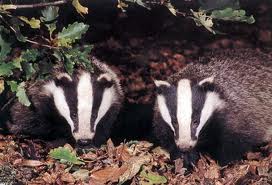
‘Sussex farmers in call for badger cull’
[BBC Sussex, 18th March 2011]
‘Sussex farmers have called for a badger cull after eight cases of bovine tuberculosis (TB) in cattle last year. Farmers want a badger cull to tackle bovine TB but wildlife
groups say it will not eradicate the disease. Sussex farmers have called for a badger cull after eight cases of bovine tuberculosis (TB) in cattle last year. The National Farmers Union (NFU) said each outbreak cost farmers thousands of pounds and the national herd was being “devastated”. Wildlife groups have objected to any badger cull and have argued the move will not affect levels of bovine TB.
Defra issued a statement which said an eradication programme would be announced as soon as possible.‘Reservoir of infection’The statement said: “Bovine TB is a devastating disease and tackling it is complex, so we need to make sure we get it right.”We will be announcing a comprehensive and balanced TB Eradication Programme for England as soon as possible.”
James Mulleneux, from the NFU, said: “Despite a huge amount of cattle controls in terms of testing and culling, we still have this reservoir of infection within badgers.”
He said the average cost to the individual farmer was £30,000 per confirmed outbreak, which was “huge” for any farming business.
He also said the disease cost the taxpayer £90m a year.
‘Larger herds’
He added: “It’s not just the financial cost, it’s actually the numbers of animals that are being taken out of the national herd.
“In 2008, we lost 40,000 head of cattle. In 2009-10, an average of 30,000. That’s not sustainable.”
But Colin Booty, a senior wildlife scientist from the RSPCA, said: “Defra’s own estimates suggest that even if culling could be undertaken according to a strict set of criteria, the best that one might achieve would be a 16% reduction in disease, not an eradication of the disease.”
And Jack Reedy, from the Badger Trust, said there were more cattle than badgers and cattle were being kept in closed conditions and larger herds, which was “a perfect prescription for passing round highly infectious diseases”.
He said: “In most of the past decade, there was a randomised badger culling trial that cost £50m.
“The main conclusion of that was that killing badgers could make no meaningful contribution and cattle measures were sufficient to do the job.”
[Source: http://www.save-me.org.uk/news/badger/article/sussex_farmers_in_call_for_badger_cull, [Viewed 20110411]
.
.
A badger ‘cull’ is an ignorant perversion.
It will only result in mass slaughter of native badgers.
It won’t control the spread of bovine tuberculosis throughout Britain’s cattle.
There are more effective smarter solutions.
If only the handful of backward badger biggots in DEFRA, the NFU and the WAG wised up.
.
.
.
Vaccinate the badgers!
.
According to an article of The Royal Society ‘Bacillus Calmette-Guérin vaccination reduces the severity and progression of tuberculosis in badgers’ published in September 2010, ..
‘the Control of bovine tuberculosis (TB) in cattle has proven particularly challenging where reservoirs of infection exist in wildlife populations.
In Britain and Ireland, control is hampered by a reservoir of infection in Eurasian badgers (Meles meles). Badger culling has positive and negative effects on bovine TB in cattle and is difficult, costly and controversial. Here we show that Bacillus Calmette-Guérin (BCG) vaccination of captive badgers reduced the progression, severity and excretion of Mycobacterium bovis infection after experimental challenge.
In a clinical field study, BCG vaccination of free-living badgers reduced the incidence of positive serological test results by 73.8 per cent. In common with other species, BCG did not appear to prevent infection of badgers subjected to experimental challenge, but did significantly reduce the overall disease burden. BCG vaccination of badgers could comprise an important component of a comprehensive programme of measures to control bovine TB in cattle.’
[Source: The Royal Society, http://rspb.royalsocietypublishing.org/content/early/2010/11/24/rspb.2010.1953, (viewed 20110411)]
.
.
Stop the dodgy farmers spreading TB!
.
Repeated reports continue to emerge of some unscrupulus cattle farmers hiding and spreading TB infected cattle. These criminals are the ones destroying Britain’s cattle industry and reputation, not the poor old badger. Read the following articles on the problem.
.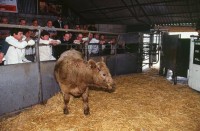
‘Farmers accused of cheating on TB slaughter rule by swapping cattle tags’
[by James Meikle, The Guardian, 31st March 2011]
‘Defra plans DNA tests for TB-positive cattle after farmers ‘disguised affected cows’ identity to avoid sending them to abattoir.
Tagged cows at a Leeds slaughterhouse. Some farmers have hidden the identity of TB-infected stock by switching ear tags, says Defra. Photograph: Christopher Thomond for the Guardian
Farmers in England face DNA checks on their cattle to prevent illegal swapping of their animals’ identities, an action the government says increases the risk of TB spreading to other herds and wildlife.
The environment department, DEFRA, said evidence was emerging that some cattle farmers in the south-west and Midlands could have been changing cattle ear tags to prevent TB-positive animals being sent to slaughter.
It is alleged that tag-switching has allowed farmers to send less productive cows to the abattoir in place of TB affected cattle.
A spokesman said three cases were already on their way to prosecution and investigations were continuing.
Cattle carry ear tags so that authorities can track their movement across the country, but from mid-April any that test positive for bovine TB will also have a DNA sample taken which will be retained by the government agency Animal Health. These samples will be cross-checked at random, or, where fraud is suspected, against the DNA of animals sent to slaughter.
The agriculture minister, Jim Paice, said: “I am absolutely appalled any farmer would deliberately break the law in this way. The vast majority of farmers with TB in their herds are doing the right thing, and it’s reprehensible that anyone should be trying to get around the tough measures helping to control TB in cattle. Anyone doing this sort of thing will be caught and have the book thrown at them.
“We are introducing this extra safeguard to minimise spread of this devastating disease to other herds and wildlife.”
The alleged evidence of fraud has emerged from an investigation instigated by Gloucestershire trading standards officers who reviewed TB cattle sent to two slaughterhouses. Investigations there and at slaughterhouses in the south-west and Midlands are continuing.
People convicted of such offences face fines of up to £5,000 and six months’ imprisonment under orders to prevent spread of TB, or 10 years’ jail and unlimited fines if prosecuted for fraud.
In 2010, about 6,000 of the 57,000 registered cattle herds in England were under TB restrictions. The new DNA measures come as controversial culls of badgers are threatened in parts of England and Wales as a means of trying to stop cattle contact with the wild animal, which is said by some observers to be an important factor in the spread of bovine TB.
Harvey Locke, president of the British Veterinary Association, said: “This fraudulent activity by a small number of farmers is shocking. Worryingly, it puts the national TB eradication strategies at risk, and urgent action is required to prevent it happening in the future.”
.
[Source: http://www.guardian.co.uk/uk/2011/mar/31/farmers-cheating-tb-swap-tags (viewed 20110411)]
.
.
‘Fines for bovine TB offences’
[BovineTB.co.uk, 22nd Feb 2011]

‘In January 2010 the largest dairy herd in the west country, Wills Bros Ltd, was put under movement restrictions following the discovery of an inconclusive reactor on their premises at Pawton Dairy, near Wadebridge, Cornwal during a pre-movement TB test. This restriction should have prevented any unlicensed movements onto or off the premises until a second and negative TB test had been obtained at least 60 days after the initial test. However, Defra vet, Cliff Mitchell, noticed an article and photo in the local paper, The Cornish Guardian, showing the Wills family with show results from the National All-Breeds Show at Stoneleigh, Warwickshire. This prompted a joint investigation by Defra vets and Cornwall Council’s Trading Standard’s animal health team. They discovered a range of errors in the herd’s records.
During the investigation it came to light that cattle had been moved between premises run by Wills Bros Ltd without appropriate TB pre-movement testing, in contravention of TB restrictions, without passports being completed and without the British Cattle Movement Service (BCMS) being informed of the movements.
Also 58 passports were found on the premises for cattle which had died more than seven days previously, the time limit for registering deaths.
In relation to the inconclusive reactor animal, it was discovered that at the time of the pre-movement test it had no official identification, and at the re-test 60 days later the animal was still not identified.
Trading Standards arranged for a DNA test of this pedigree animal and it was found that there was no biological link between it and the animal that was registered as its mother with both the BCMS and Holstein UK, the pedigree society.
John Pascoe, of Cornwall Council’s Trading Standards, said: “During the investigation of this case, serious deficiencies in the recording, reporting and monitoring of cattle births and deaths were uncovered. It is vitally important for the farming industry to adhere to these controls, which enable rapid tracing of animal movements. Non compliance, such as those found, can have devastating effects for the whole of the farming industry if a disease situation develops.” He also said it had not been the first time his inspectors had found problems with cattle passports. They should be returned within seven days of the death of an animal under the Cattle Identification Regulations 2007
Investigators from the Department for Environment, Food and Rural Affairs (Defra) and Cornwall Council Trading Standards found:
- Cattle had been moved between premises run by the dairy without TB pre-movement testing; passports had not been completed;
- 58 cattle passports were found on the premises for cattle which had died more than seven days previously;
- The British Cattle Movement Service (BCMS) had not been informed; · DNA tests of the suspect animal found no biological link between it and the animal registered as its mother;
- At the re-test 60 days later the animal was still not identified.
In February 2011 Wills Bros pleaded guilty to seven offences under the tuberculosis and cattle identification legislation of 2007, which is part of the Animal Health Act. The company was fined £7,200 and ordered to pay costs of £7,140 at Bodmin Magistrates Court after a report about a prize-winning cow appeared in a local newspaper when the herd was under a disease movement restriction order
The only comment we have found on the case comes from the Badger Trust. Patricia Hayden, Vice Chairman of the Badger Trust, said:
“These offences were committed in the heart of a major bTB hotspot. They risked the health of prime stock at a major cattle show and the wellbeing of pedigree herds and farm businesses all over the country. The discovery of so many passports overdue for return to the British Cattle Movement Service also raises serious questions about the reliability of the system. Transparency is crucial when bovine tuberculosis is causing serious economic harm to farm businesses.
“If other cattle at the show had been infected, unthinking advocates of culling badgers would have been quick to claim their case had been proved. As it is, many farmers in Cornwall could yet be licensed to shoot badgers in the mistaken belief that it will help to eradicate the disease.
“We have been warning the industry for almost 30 years about the danger of moving untested cattle and we have welcomed the belated controls of the last five years. As happened 50 years ago those controls now seem to be succeeding without killing any badgers.”
.
Source: http://www.bovinetb.co.uk/article.php?article_id=77, (viewed 20110411)]
.
.
Our Value Judgment:
.
Britain’s national problem of Bovine Tuberculosis infecting cattle is one of a contagious disease caused by Mycobacterium bovis. The solution lies in controlling the disease in cattle, through vaccination, thorough and frequent testing and strict controls on cattle movement.
That the disease has spread from cattle to wildlife, reflects an ineptitude of the farming community to self-regulate and weed out the criminal cattle operators amongst them and the failure of governments to control and eradicate the disease across Britain’s cattle industry. It also reflects an ineptitude of Britain’s environmental authorities to prevent the spread of the contagion amongst Britain’s wildlife.
That the native badger has been singled out and targeted for mass slaughter is pointless and senseless. Science has demonstrated that mass slaughter of badgers will not control bovine tuberculosis. A few backward terriermen with cruel 18th Century mindsets continue to demonised the badger. What these handful of badger bigots propose is nothing short of a hate crime against Britain’s wildlife. The union dues used the National Farmers Union and the British taxpayers funds financing DEFRA are being grossly misused to pursue this perverted policy.
Those public servants doggedly advocating mass slaughter of Britain’s badgers, Welsh Rural Affairs Minister Elin Jones, UK’s Agriculture Minister James Paice, and NFU president Peter Kendall should be sacked for incompetence and for inciting hate crime against protected wildlife.
Leave the badgers alone!
Stop the senseless slaughter of badgers!
.
.
Badger Protection League
.
“For me, Badgers represent everything that I love about the English Countryside and I am saddened and appalled that the slaughter of thousands of badgers is planned for England and Wales from May 2011. Whilst I have empathy with farmers struggling to control the spread of Bovine TB it has been irrefutably proven that culling badgers will not resolve this issue. A more cost effective, and certainly more humane, way of managing this disease would be to trap and vaccinate badgers before releasing them back into the wild but instead they are to be culled. Farmers/landowners are to be given licenses to cage trap and shoot badgers, or to shoot free running badgers.”
[ Anthony Head, Badger Protection League, UK, 20110328, http://www.badgerprotectionleague.com/article.php?id=34)]
.
The Badger Protection League ‘is an independent website supported by many societies, groups, VIP’s and Celebrities. We need you to help us in fighting against the proposed killing of thousands of badgers in England and Wales. Unless we make our voices heard, badgers will be killed from May 2011. They will either be cage trapped and shot or shot free running despite the protection legislation afforded to them.
It cannot be emphasised enough as to how important each of these actions are in the fight against badger culling – Please show that you care.
Badgers need you more than ever TODAY!’
.
.
The Badger Trust
.
“Letters sent to David Cameron, Nick Clegg, Caroline Spelman and James Paice. Defra’s sudden, massive and expensive response to the scandal of farmers switching ear tags to foil bovine TB (bTB) controls suggests these crimes are widespread rather than local. Following the disclosure of these frauds the Badger Trust has called for all plans to kill badgers in England and Wales to be abandoned.
An investigation instigated by Gloucestershire Trading Standards exposed the deceptions when reviewing TB cattle sent to two slaughterhouses. As a result of the switching of ear tags, infected animals were being retained in herds. Claims by agriculture industry organisations that only “some” farmers were involved are clearly optimistic with the Midlands and the South West already implicated.”
.
[Source: The Badger Trust, ^http://www.badger.org.uk/Content/Home.asp]
.
Badger Trust ‘promotes the conservation and welfare of badgers and the protection of their setts and habitats for the public benefit. We are the leading voice for badgers and represent and support around 60 local voluntary badger groups. Badger Trust provides expert advice on all badger issues and works closely with Government, the police and other conservation and welfare organisations.’
 Native Badgers
~ a diet of earthworms Native Badgers
~ a diet of earthworms
.
.
Footnote
.
‘Until recently badgers did little to damage the hedgehog population because the smaller animals had plenty of places to hide.
However, the loss of hedgerows and the spread of intensive farming has reduced cover.
Although badgers prefer a diet of earthworms, they will eat hedgehogs when they are hungry enough.
The study found that the eastern counties of England are the best place in Britain for hedgehogs.
Fay Vass, of the British Hedgehog Preservation Society, said badgers were only part of the problem.
“The main reason numbers are falling is the loss of habitats and the fragmentation of their habitat,” she said.
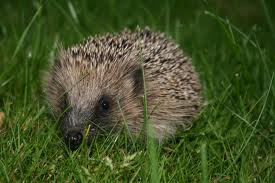 Native Hedgehog
~ diet of earthworms Native Hedgehog
~ diet of earthworms
“They like to roam two miles each night, but there are more walls and fences to block their way.”
.

Preferred badger food …if the badgers are left alone.
.
.
Somerset badgers fall victim to poisoning campaign
.
‘SECRET World Wildlife Rescue carers are astounded by the amount of badgers admitted to the charity showing signs of poisoning in recent days.
Volunteers at the East Huntspill centre have seen several badgers taken in with neurological symptoms caused by poison. One badger died soon after arrival, another is on a drip and a third is seriously ill. A fourth was revived and carers hope to release it back into the wild.
Centre care manager and veterinary nurse Sara Cowan said:
.
“I have not seen such critical signs of poisoning in all my years as a nurse. The faeces from one badger was florescent green from the poison – it was that bad. We suspect people are putting poison in food and leaving it near badger setts.”
.
The situation has been reported to police who are investigating.’
.
.
References and Further Reading:
[1] The Badger Trust ^http://www.badger.org.uk/
[2] Save the Badger ^http://www.savethebadger.com/
[3] Protection of Badgers Act 1992, ^http://www.legislation.gov.uk/ukpga/1992/51/contents
[4] Worcestershire Badger Society ^http://www.worcestershirebadgersociety.org.uk/
[5] Badger Protection League ^ http://www.badgerprotectionleague.com/
[6] ‘NFU publishes position on badger culling‘, Farmers Guardian, 13th Dec 2010, http://www.farmersguardian.com/home/livestock/livestock-news/nfu-publishes-position-on-badger-culling/36166.article
[7] ‘Bacillus Calmette-Guérin vaccination reduces the severity and progression of tuberculosis in badgers’, The Royal Society, 10th September 2010, http://rspb.royalsocietypublishing.org/content/early/2010/11/24/rspb.2010.1953
[8] DEFRA on bTB http://www.defra.gov.uk/food-farm/animals/diseases/tb/
[9] Badger Watch and Rescue Dyfed http://www.badger-watch.co.uk/
[10] Scottish Badgers http://www.scottishbadgers.org.uk/
[11] Essex Badger Protection Group http://www.essexbadger.co.uk/
[12] Herts and Middlesex Badger Group http://www.hmbadgergroup.org.uk/
.
– end of article –
Tags: Bacile Calmette Guerin (BCG), badger, Badger (Control Area) (Wales) Order 2010, Badger Baiting, Badger Control, Badger Cull, badger destruction order, Badger Protection League, Badger Trust, badger vaccination, Bovine TB, Bovine TB Eradication Programme, British Cattle Movement Service, British Hedgehog Preservation Society, DEFRA, existence rights, hate crime against protected wildlife, hedgerow removal, Independent Scientific Group, Meles meles, Save the Badger, The Krebs Trial, Worcestershire Badger Society
Posted in 07 Habitat Conservation!, 23 Conservation Funding!, 34 Wildlife Conservation!, 36 Tests of Harm!, Badgers, Threats from Farming, Threats from Poaching and Poisoning | No Comments »
Add this post to Del.icio.us - Digg
Saturday, March 26th, 2011
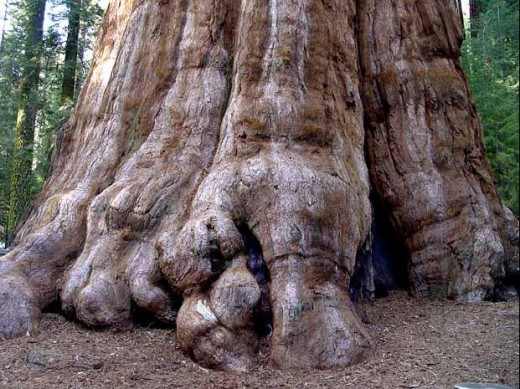 ‘General Sherman’ ~ just another sequoia? (pronounced ‘sequoya’)
Sequoia & Kings Canyon, Sierra Nevada, California, USA
^http://www.nps.gov/seki/historyculture/gfgst.htm ‘General Sherman’ ~ just another sequoia? (pronounced ‘sequoya’)
Sequoia & Kings Canyon, Sierra Nevada, California, USA
^http://www.nps.gov/seki/historyculture/gfgst.htm
.
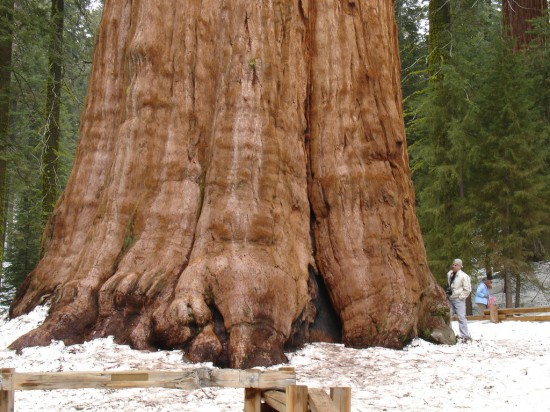 The General Sherman Tree
– the world’s largest tree, is the prime visitor attraction in the Giant Forest.
[Source: ^http://www.nps.gov/seki/historyculture/gfgst.htm]
. The General Sherman Tree
– the world’s largest tree, is the prime visitor attraction in the Giant Forest.
[Source: ^http://www.nps.gov/seki/historyculture/gfgst.htm]
.
“Sequoia sempervirens’ common names include coast redwood, California redwood, and giant redwood. It is an evergreen, long-lived, monoecious tree living 1200–1800 years or more. This species includes the (current) tallest trees on Earth, reaching up to 379 feet (115.52 m) in height and up to 26 feet (7.9 m) diameter at breast height. Before commercial logging and clearing began by the 1850s, this massive tree occurred naturally in an estimated 2.1 million acres along much of coastal California (excluding southern California where rainfall is not abundant enough) and the southwestern corner of coastal Oregon within the United States.” [Source: ^Wikipedia – read more].
.
“The Sierra Nevada is still growing today. The mountains gain height during earthquakes on the east side of the range. But the mountains are being shortened by erosion almost as quickly as they grow. This erosion has deposited sediments thousands of feet thick on the floor of the San Joaquin Valley.”
[Source: ^http://www.nps.gov/seki/historyculture/gfgst.htm]
.
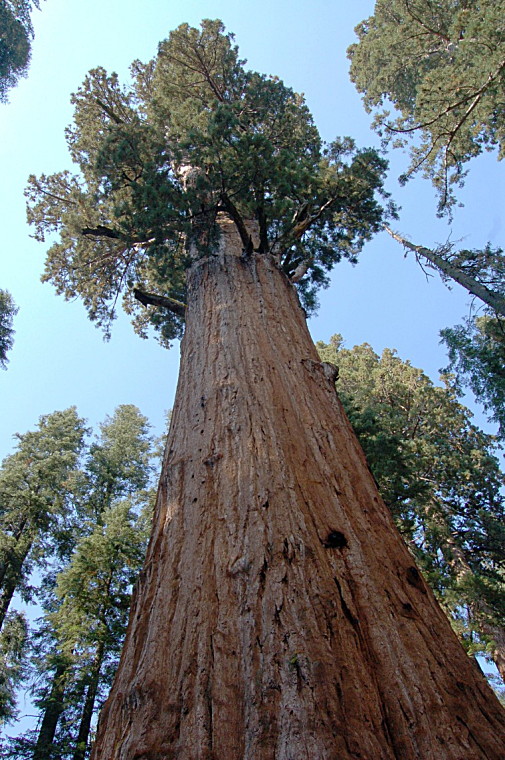
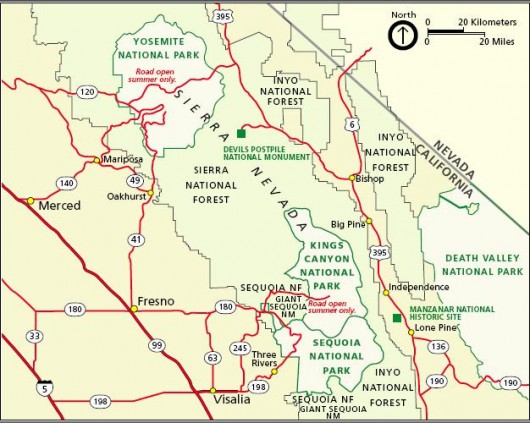
.
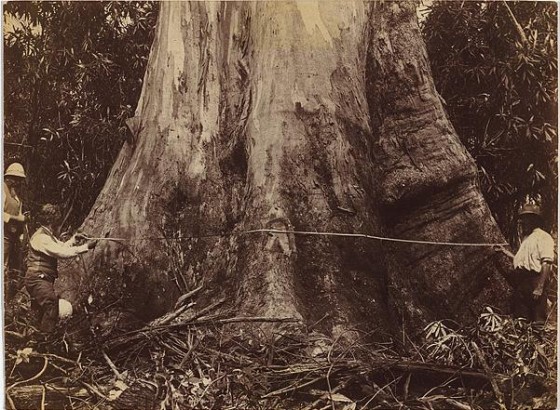 ‘Giant tree’ at Neerim (Gippsland, Victoria, Australia), forty feet girth c.1889
AUSTRALASIAN ART, Photo by Nicholas CAIRE, b.1837 Guernsey, United Kingdom – Australia d.1918[Gelatin silver photograph image 15.0 h x 20.2 w cm, Purchased 1983, Accession No: NGA 83.3083]
.
.
“The men shown here measuring the diameter of a giant eucalypt were not loggers or tree-lovers. They were attempting to determine whether Australian trees were bigger than the famed 400-foot giant redwoods of California. It was mostly national pride surrounding the Australian Centennial of European settlement which motivated scientists and photographers in the 1880s to seek out the remaining giant trees in the more remote areas of Victoria. The Americans claimed that their redwoods were the greatest because of their combined height and girth. In the dense Australian bush, it
was easier to measure the girth than the height and presented a much more dramatic image for a photograph.
.
The general public followed the giant tree debate in the papers and also purchased photographs of them and other idyllic bush scenes. By the late 19th century, the Australian population mostly lived and worked in the cities. They became day-trippers and used the new railway networks to take their recreation in the bush. Nicholas Caire, one of the most active photographers to seek out and record the giant trees, travelled over a number of years on the new rail line to Neerim town reserve.
.
Australia’s giant trees were widely depicted in colonial art as mighty symbols of the pre-settlement and pioneer era. Caire, whilst accepting the desirability of logging and urban development, was also one of those who argued for the preservation of examples for future generations.
.
Most of the awesome giant trees were felled or burnt in his lifetime. Now they are preserved only in photographs.” ‘Giant tree’ at Neerim (Gippsland, Victoria, Australia), forty feet girth c.1889
AUSTRALASIAN ART, Photo by Nicholas CAIRE, b.1837 Guernsey, United Kingdom – Australia d.1918[Gelatin silver photograph image 15.0 h x 20.2 w cm, Purchased 1983, Accession No: NGA 83.3083]
.
.
“The men shown here measuring the diameter of a giant eucalypt were not loggers or tree-lovers. They were attempting to determine whether Australian trees were bigger than the famed 400-foot giant redwoods of California. It was mostly national pride surrounding the Australian Centennial of European settlement which motivated scientists and photographers in the 1880s to seek out the remaining giant trees in the more remote areas of Victoria. The Americans claimed that their redwoods were the greatest because of their combined height and girth. In the dense Australian bush, it
was easier to measure the girth than the height and presented a much more dramatic image for a photograph.
.
The general public followed the giant tree debate in the papers and also purchased photographs of them and other idyllic bush scenes. By the late 19th century, the Australian population mostly lived and worked in the cities. They became day-trippers and used the new railway networks to take their recreation in the bush. Nicholas Caire, one of the most active photographers to seek out and record the giant trees, travelled over a number of years on the new rail line to Neerim town reserve.
.
Australia’s giant trees were widely depicted in colonial art as mighty symbols of the pre-settlement and pioneer era. Caire, whilst accepting the desirability of logging and urban development, was also one of those who argued for the preservation of examples for future generations.
.
Most of the awesome giant trees were felled or burnt in his lifetime. Now they are preserved only in photographs.”
~Anne O’Hehir
.
Indeed…
“The largest tree on Planet Earth is not the California Redwood, but the Mountain Ash (Eucalyptus regnans). The largest trees ever recorded were located in southern Australia near present day Melbourne. The world’s largest tree was the Ferguson Tree at over 500 feet (154m). It was measured by Surveyor Ferguson in 1872 in the Watts River Catchment near Healesville.”
Read More: Click: http://www.baddevelopers.green.net.au/Docs/talltrees.htm
.
Source: Text © National Gallery of Australia, Canberra 2010, Anne Gray (ed), Australian art in the National Gallery of Australia, National Gallery of Australia, Canberra, 2002, http://cs.nga.gov.au/Detail-LRG.cfm?IRN=106546&View=LRG
.
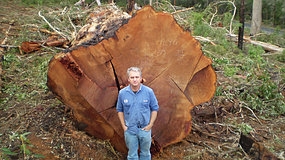
.
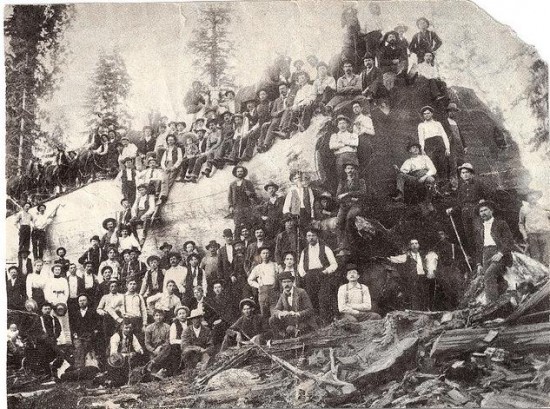 People and Horses on a Gigantic Redwood Log; about 1900.
“This photo is open for down loading for anyone wishing a free copy. Unknown Photo History. I’m fairly certain the tree was a Coast Redwood (Sequoia semperviren) or a Giant Sequoia (Sequoiadendron giganteum) from Central to Northern California or Oregon. I wish this one was still standing. The bark has already been stripped off of it.” [Source: Photo of old photo by David Foster, http://www.flickr.com/photos/21734563@N04/2225069096/] People and Horses on a Gigantic Redwood Log; about 1900.
“This photo is open for down loading for anyone wishing a free copy. Unknown Photo History. I’m fairly certain the tree was a Coast Redwood (Sequoia semperviren) or a Giant Sequoia (Sequoiadendron giganteum) from Central to Northern California or Oregon. I wish this one was still standing. The bark has already been stripped off of it.” [Source: Photo of old photo by David Foster, http://www.flickr.com/photos/21734563@N04/2225069096/]
.
.
Editor’s Comment:
I empathise with David Foster. – ‘I wish this one was still standing‘. Every face in this 1900 photo conveys cultural achievement and exploitative pride.
Now in 2011, has human attitude and on-ground impact toward ‘Old Growth’ really changed any?
Consider ‘Merbau’ timber, readily available from local timber yards across Australia and in New Zealand as ‘Kwila’ (Botanical names: Intsia bijuga and Intsia palembanica). Comparable old-growth rainforest hardwoods include Narra, Yakal, and Ipil. These old growth giants continually to be currently logged illegally deep in rain forests of the Philippines, Solomon Islands, Fiji and Papua New Guinea. Australian and New Zealand households profit from SE Asian rain forest destruction.
The lost natural assets of giant trees, of old growth have diminished the Earth, and have diminished the value of humanity, and of humanity’s value to the Earth. To forest habitat we are but marauders and rapists.
Humanity has become ‘Earth’s Pathogen’.
.
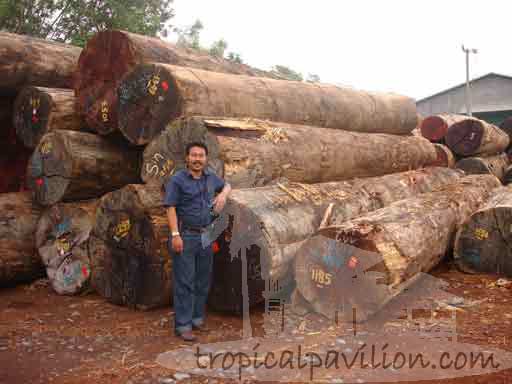 . .
 SE Asia old growth Rainforest Kwila is marketed in Australia and New Zealand as ‘Merbau’
for use mainly in flooring and decking,because of its relative hardness (high Janka rating) and long term stability. SE Asia old growth Rainforest Kwila is marketed in Australia and New Zealand as ‘Merbau’
for use mainly in flooring and decking,because of its relative hardness (high Janka rating) and long term stability.
.
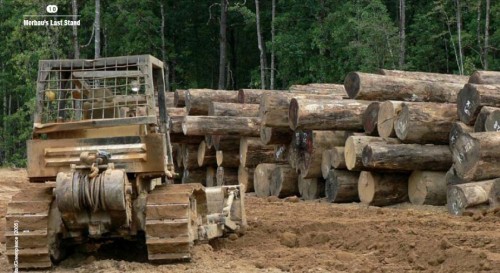
.
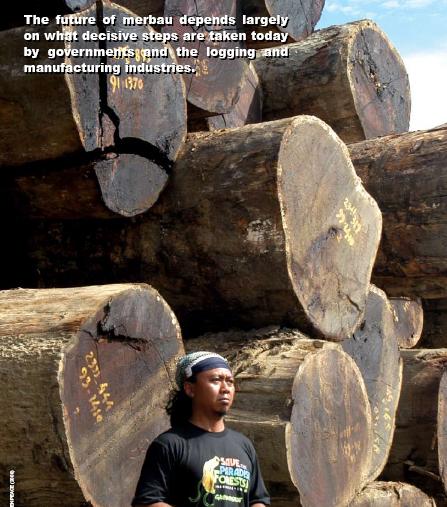
.
.
Rimbunan Hijau Group of Companies
.
“Malaysia’s largest timber group is Rimbunan Hijau (“Forever Green”) (Forbes, 1995). It has timber concessions in Sarawak of around 800,000 hectares (FT,1994), dominates Papua New Guinea’s forestry sector and has forestry interests in New Zealand and China, as well as diversifying into other activities such as the ownership of newspapers in Malaysia and Papua New Guinea (AsiaMoney, 1995). Rimbunan Hijau also owns a 40% share in Limgang Trading Sdn., which has a 310,000 hectares concession in Sarawak (55% of Limbang is owned by Sarawak’s Minister for the Environment and Tourism, James Wong Kim Min) It is privately owned and controlled by one family, headed by Tiong Hiew King. The family are estimated to be worth about US$2.5 billion (Forbes, 1995).”
“Whilst it remains largely a private group of companies, whose operations are veiled in secrecy, the Tiong family has sought to obtain a more public face through the reverse take-over of Berjaya Textiles Bhd (now renamed Jaya Tiasa Holdings Bhd), giving it a listing on the Kuala Lumpur Stock Exchange (FT 1994). Its overseas logging operations appear to remain under the control of the private parts of the group and in Papua New Guinea it is the dominant player through control of a number of associate and subsidiary companies. There are recent rumours that Rimbunan Hijau group owns, or is in the process of acquiring, Primegroup Holdings, a British Virgin Islands registered company with logging interests in Guyana and Papua New Guinea. If this is true, then Rimbunan Hijau group’s international logging interests are, or will shortly become, even more extensive, both geographically and in terms of size. Apart from its logging activities, the company has interests in banking, newspapers and oil-palm plantations. One of Hiew King’s younger brothers is a member of the Malaysian Parliament. Despite the company’s political connections, it has been caught for tax evasion, the Asian Wall Street Journal reported.”
.
[Source: Greenpeace, 1997, http://archive.greenpeace.org/comms/97/forest/asian_companies_malaysia.html, accessed 20110325].
.
“Rimbunan Hijau is a Malaysian based global forest logger and controls around 60% of the forest industry in Papua New Guinea. Rimbunan Hijau is Logging vast areas of virgin PNG forest against national opinion and local customs which infringes on the traditional rights of indigenous resource owners.
- (It is) accused in PNG Government reports of gross human rights abuses, labor abuses, sexual abuses and illegal logging.
- Causing destruction of ancient natural forest and associated systems.
- Conducting broad scale industrial logging operations that infringe on the rights of local people to establish and exploit alternative economic opportunies.
- Is influencing political and other processes to gain and maintain a near monopoly on PNGs forest resources and avoid adequate scrutiny and monitoring of its operations.
- Rimbunan Hijau uses the media to promote its operations to the PNG public – Rimbunan Hijau already OWNS The National newspaper and LEGAL THREATS against their only competitor, the Post Courier, have left it wary of criticising Rimbunan Hijau. These have been the only two print media outlets since The Independent was closed down.”
.
[Source: http://www.forestnetwork.net/rhw/]
.
Rimbunan Hijau is ultimately 50% owned by the Boral “Group” of Australia and 50% by Caltex.
[Source: http://www.scribd.com/doc/24211537/2258-Christchurch-New]
.
…so when Australians and New Zealanders buy Merbau timber from local timber yards, hardward stores and furniture retailers – they are driving South East Asian old growth rainforest deforestation.
.
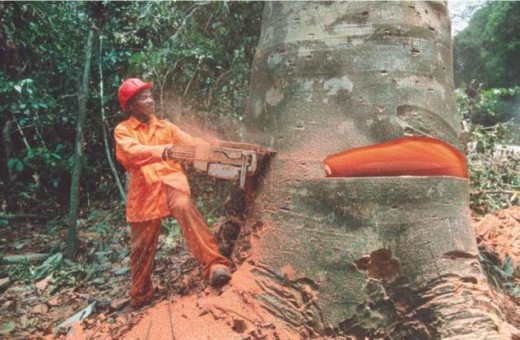
.
.
(The following article from The Guardian in February 2011 is by forests officer for WWF Indonesia, Jimmy Bond, based in West Kalimantan on the island of Borneo)
.
Complacency over deforestation pushes orang-utan closer to extinction
.
“Illegal logging and hunting continues despite legal protection, so the WWF is raising awareness to help save the orang-utan.
The destruction of the world’s rainforests continues at an alarming rate. Where I’m from in Borneo, illegal logging, coupled with hunting, is driving species such as the orang-utan ever closer towards extinction.
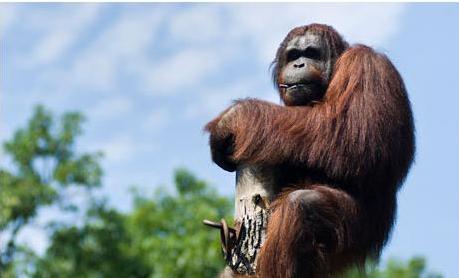 Borneo male orang-utan Wandoo.
There are fewer than 2,000 wild orangutans left in the West Kalimantan province, Indonesia.
©Photograph: Attila Balazs/epa/Corbis Borneo male orang-utan Wandoo.
There are fewer than 2,000 wild orangutans left in the West Kalimantan province, Indonesia.
©Photograph: Attila Balazs/epa/Corbis
.
There are three subspecies of orangutan in Borneo and we only have about 2,000 orangutans left in the wild in West Kalimantan province, and through deforestation and hunting their numbers continue to fall. Just last month I heard from villagers that some people are still killing and eating them even though they’re supposed to be protected by law.
I’ve just been travelling around the region in this part of Indonesia as I’ve been running a series of summer schools as part of a WWF awareness campaign to highlight the problems facing the orang-utan.
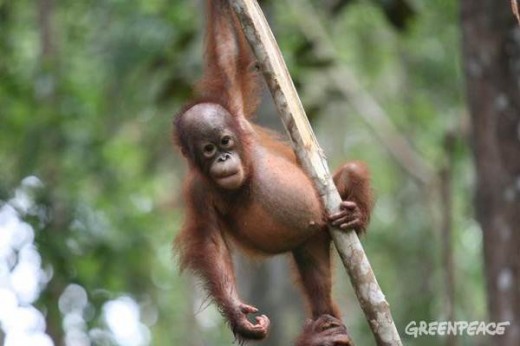
Over the past two years, the main focus for the campaign has been children because we’ve found it very difficult to change the minds and attitudes of older generations. We invite the kids to come along to these camps from nearby villages and at the last one more than 200 kids turned up. We do many different activities from drawing to tug-of-war competitions but the over-arching aim is to touch their hearts with stories about this wonderful creature and the rainforests in which they live. We want to leave them with the understanding that these unique creatures need protecting.
We’re also starting to join forces with local government officials and religious leaders to spread the message to communities that live in traditional longhouses. We tell them about a recent success story that acts as a warning against killing orang-utans. One trader in Pontianak, where I’m based, was recently jailed for two years for trading orang-utans.
Such discussion also helps us talk about their habitats and the need to protect them too. In West Kalimantan from 1995, large-scale illegal logging cut through a forest corridor that linked two national parks where one of three subspecies of orang-utan (Pongo pygmaeus pygmaeus) lives. This meant they couldn’t migrate between the two areas and their numbers dropped significantly. This was made worse because the illegal loggers who came here to work also hunted meat from the forests and the orang-utans were in the firing line.
Over the past few years we’ve been trying to highlight these problems to the international media because some of the illegally logged timber was transported over the border to Malaysia where it is made into wood products that are shipped all over the world. Globally, we want people to become educated about where the timber that makes their furniture comes from and the harm it is doing to species and communities. When the forest disappears people no longer have access to food and medicines plus we have also seen more flooding as a result of deforestation. The international media focus also helps push our government to react because not so long ago they were doing nothing to help.
Recently, we’ve seen companies get permits from the government to develop palm oil plantations. But what’s worse is that the permits are just a smokescreen for the companies to get at the timber and leave without planting any palm oil.
So we’re working to make indigenous communities aware of this practice and the best way to do this is by bringing in others who have seen this happen on their land to warn them. If they are forewarned then they know not to allow it to happen to their own communities. These people need to have the forest in good condition because it’s not only home to different species, it’s also where they earn their livelihood.
Looking to the future, my big ambition is to set up an orang-utan rehabilitation centre here in West Kalimantan for subspecies Pongo pygmaeus pygmaeus. At the moment, orphaned babies are taken to other parts of the country where they are kept with the two other subspecies. I want them to be able to breed with their own kind otherwise they could die out. And I fear that if the orangutan disappears, the rainforest won’t last much longer either.”
[Source: The Guardian newspaper (UK) , http://www.guardian.co.uk/environment/blog/2011/feb/03/indonesia-deforestation-orangutan-extinction, accessed Feb 2011]
.
.
Further Reading
.
http://www.nps.gov/seki/historyculture/gfgst.htm
http://en.wikipedia.org/wiki/Intsia_bijuga
http://www.indonesianrainforest.org/irf-news/373-campaign-against-kwila-imports-continues-.html
http://rainforest-action.blogspot.com/2010/09/end-sales-of-kwila-timber-products.html
http://www.greenpeace.org/new-zealand/en/press/illegal-kwila-timber-imports-f/
http://www.info-ri.com/indonesia/rainforest-action-end-sales-of-kwila-timber-products/
http://www.robcousens.com.au/files/D512143129.pdf
http://www.dansson.com/kwila.htm
http://www.greenpeace.org/international/Global/international/planet-2/report/2008/7/merbau-report-2.pdf
Greenpeace, 1997, http://archive.greenpeace.org/comms/97/forest/asian_companies_malaysia.html
http://www.coolearth.org/306/whats-new-32/news-155/illegal-logging-threatening-malaysian-wildlife-453.html
http://www.wwf.org.my/media_and_information/wwf_position_statements/?5741
http://www.ewp.asn.au/certification/certificationcoc.html
http://www.forestnetwork.net/rhw/
http://www.atif.asn.au/
http://www.scribd.com/doc/24211537/2258-Christchurch-New
http://www.baddevelopers.green.net.au/Docs/talltrees.htm
The Guardian newspaper (UK) , http://www.guardian.co.uk/environment/blog/2011/feb/03/indonesia-deforestation-orangutan-extinction
.
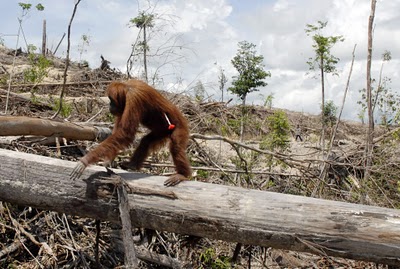 . .
Tags: Boral Group, Californian redwood, Caltex, commercial logging, deforestation, Earth's Pathogen, Eucalyptus regnans, Ferguson Tree, General Sherman Sequoia, Giant Forest, giant redwood, Guam, hallowed majesty, human pathogen, illegal logging, Intsia bijuga, Janka rating, Kalimantan, Kwila, Merbau, merbau flooring, Merbau's last stand, Narra, Neerim, old growth conservation, old growth forest, orang-utan, orang-utan extinction, Oregon, Primegroup Holdings, Rainforest Kwila, Rimbunan Hijau, San Joaquin Valley, Sarawak, Sequoia sempervirens, Sequoiadendron giganteum, Sierra Nevada, significant trees, world's largets tree, Yakal
Posted in 31 Old Growth Conservation!, Congo (CD), Kalimantan (ID), Sumatra (ID), Threats from Deforestation | No Comments »
Add this post to Del.icio.us - Digg
Thursday, March 24th, 2011
 Golden Bandicoot is under threat of extinction in The Kimberley. Golden Bandicoot is under threat of extinction in The Kimberley.
.
“Australia has the worst extinction record for mammals of all countries in the world (Johnson 2007), and has international obligations (Convention on Biological Diversity 2006) and national commitments (Commonwealth of Australia 1999) to avoid species extinctions. Meeting these obligations will require effective and ongoing conservation management.”
[Source: Priority threat management to protect Kimberley wildlife, p47,CSIRO Ecosystem Sciences, Feb 2011, Australia]
.
.
.
At 6am on 1st June 1990, I started my prepared and serviced HT Holden outside my father’s place in Melbourne and executed my planned drive mission across to Adelaide then up the Centre to Kununurra in the East Kimberley. I was 26; I had saved up. I was on a mission to get my commercial helicopter license and to work in cattle mustering in the Kimberley in the process to ‘get my hours up’.
The Kimberley was a very hot and steamy; a world away from temperate urban Melbourne.
Well, after some months and growing up in a remote landscape, I did achieve my license with Golden West Helicopters, then did some mustering. I took risks, recalling pivot turns over isolated beaches and I learnt a lot…what city kids should.
Some memories that will remain with me (until my memory doesn’t) are the waking to East Kimberley bird calls from the pilot shack at the red dusty caravan park down the road from Kununurra Airport. When building my cross-county and low-level endorsement hours up, I will never forget flying the R22 low over wild rivers full of long lizards (crocs), or slowly navigating the thick mist at 50 foot AGL at dawn, or flying free over the wide rugged red rock landscape, or finding the eagles nest on a remote hill miles off in some north westerly direction from Kununurra. My memory of the Kimberley is of a wild special place, like Emma Gorge and the amazing remote drive to Wyndham – so isolated – so free. But it is the unique bird calls that recur in my memory of the magic natural tropical home of The Kimberley.
So when I now later learn that the Kimberley and its scarce wildlife are under threat, I have no hesitation posting the following article to advocate the urgency of the Kimberley’s wildlife conservation.
The Kimberley is indeed like nowhere else!
~ Editor
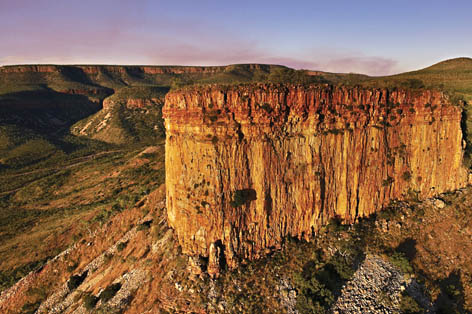
.
.
According to the findings of a current ecological study and report published in February 2011 by the CSIRO and The Wilderness Society:
“up to 45 native species in the Kimberley region will die out within 20 years if no action is taken”.
.
The report found that the two most destructive threats to survival of native species are:
-
Feral cats
-
Frequent large scale fire regimes (deliberate or neglected)
.
It has called for an immediate cash injection of $95 million to save wildlife like the Golden Bandicoot, the Scaly-tailed Possum and the Monjon Rock Wallaby from extinction. Even with the current $20 million per year spent on Kimberley conservation the region is still set to lose some 31 native animals, according to the report.
The report is a culmination of collaborative ecological research and workshops was undertaking across the Kimberley region by scientists with the CSIRO’s Ecosystem Sciences, along with The Wilderness Society, Australian Wildlife Conservancy, Fenner School of Environment and Society (ANU), and The Ecology Centre at the University of Queensland. Its authors from these organisations include Josie Carwardine, Trudy O’connor, Sarah Legge, Brendan Mackey, Hugh Possingham and Tara Martin. Regrettably, the only contributing organisations permanently based in the Kimberley appear to be the Kimberley Land Council and Environs Kimberley. Perhaps this is half the problem; the other half being ye ol’ lack of political will, because surely Australia has plenty of taxpayer funds in circulation.
If ever the ecological precautionary approach principle was a vital precondition of human actions, the Kimberley is the place where it most applies. The recurring theme throughout the report is the lack of comprehensive survey data from the region. Ecologically, the Kimberley is grossly data deficient. Consequently, humans know not what they do, nor what the impact of what they do is, nor how close the thirty odd threatened and endangered native animals are to regional extinction.
The Scaly-tailed Possum (Wyulda) , Monjon Rock Wallaby and the Cave-dwelling Frog are thought to be uniquely endemic to the region, so if they are wiped out from the Kimberley, as a species they will become globally extinct, like the Tasmanian Tiger (Thylacene) and the Dodo.
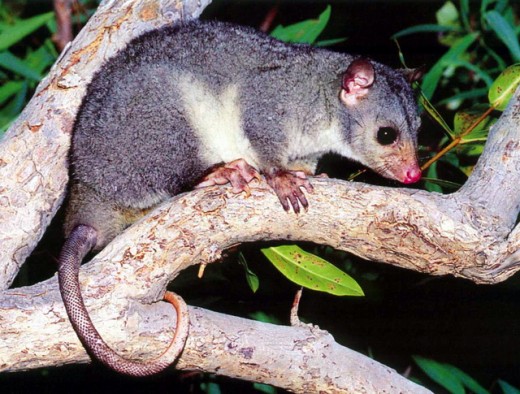 Wyulda, or Scaly-tailed Possum (Wyulda squamicaudata)
endemic to the Kimberley, and highly sensitive to bushfires Wyulda, or Scaly-tailed Possum (Wyulda squamicaudata)
endemic to the Kimberley, and highly sensitive to bushfires
.
Due to human encroachment and habitat destruction across northern Australia and the ferals and destructive practices they have brought with them, the still mainly wild Kimberley remains the last survival refuge for many of Australia native at-risk species.
Native vertebrate fauna of the Kimberley like the Northern Quoll, Golden-backed Tree-Rat, Golden Bandicoot, Gouldian Finch, Spotted Tree Monitor, Western Chestnut Mouse, and Stripe-faced Dunnart are at serious risk of extinction.
.
Priority Threat Management Actions for The Kimberley
.
Experts identified key broadscale threat management actions for improving wildlife persistence (p5):
1. Combined management of fire and introduced herbivores! – feral donkeys, cattle, horses, pigs
2. Eradication, control, quarantine of weeds! – rubber vine, gamba grass, mesquite, passionfruit
3. Control of introduced predators! (particularly feral cats)
.
“The single most cost-effective management action would be to reduce the impacts from feral cats (at $500,000 per bioregion per year) with a combination of education, research and the cessation of dingo Baiting.” [p.6-7]
.
While anticipated to have low feasibility of success, the feasibility has not been started nor tested.
“The next most cost-effective action is to manage fire and introduced herbivores (at $2–7 million per bioregion per year); this action is highly feasible and, if implemented effectively, would generate large improvements in probabilities of persistence for almost all wildlife species.” [p.6-7]
.
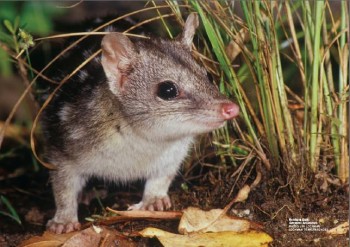 Northern Quoll (Dasyurus hallucatus)
Native to the Kimberley, but seriously at risk from feral cats and bushfires Northern Quoll (Dasyurus hallucatus)
Native to the Kimberley, but seriously at risk from feral cats and bushfires
.
.
Natural Integrity and (Human) Threats
.
.
Threats to The Kimberley from ‘Bushfire Management’
.
“Frequent, extensive and very hot fires in the Kimberley affect its ecosystems in several ways. They change the structure and composition of vegetation, endangering some species of plants and removing important wildlife habitat refugia. They also leave the ground unprotected from the heavy monsoonal rains, causing soil erosion and later stream sedimentation.”
Inappropriate fire regimes pose a threat to biodiversity in the Kimberley and across northern Australia (e.g. Bowman et al. 2001; Russell-Smith et al. 2003). Historically, Indigenous people managed fire throughout the region, which included fine scale prescribed burning across a variety of vegetation types and around important cultural and food resource sites, such as rainforest patches. This most likely resulted in a mosaic of burnt and unburnt vegetation and provided buffers against unplanned wildfires around critical biodiversity refuges (Environmental Protection Authority 2006).

Broadscale State-sanctioned Arson of the Kimberley
(Photo: Ed Hatherley, Western Australia Department of Environment and Conservation)
[Source: ^http://www.australiangeographic.com.au/journal/new-fire-plan-for-the-kimberley.htm]
.
These fire patterns have been replaced in the past few decades with one that is increasingly dominated by extensive and intense mid to late dry season fires. As a consequence, the mean age (and variance) of the vegetation has declined (Legge et al. 2010).
Altered fire regimes interacting with other degrading processes, especially over-grazing, have led to structural and floristic change in vegetation, declines in vegetation cover and critical resources such as tree hollows. They are also associated with increased soil erosion after heavy rains (doubled erosion rates have been recorded in similar situations in the Top End of the Northern Territory (Townsend and Douglas 2000), leading to increased sedimentation in stream beds. These changes have severe negative impacts on native flora and fauna (Vigilante and Bowman 2004; Legge et al. 2008). Extensive flat savanna areas are more vulnerable to large intense fires, as there are fewer inflammable refugia such as rocky areas.
Without appropriate management, the impacts of fire are likely to increase as the region is predicted to become even more fire prone with ongoing climate change (Dunlop and Brown 2008)”. [pp.11-12]
.
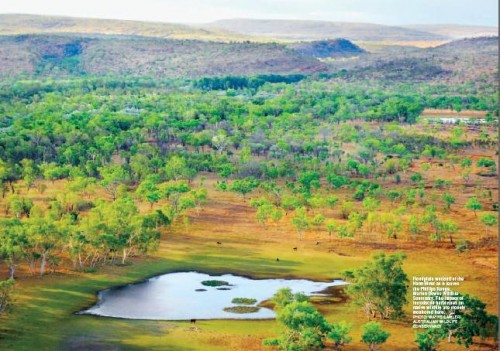 Floodplain wetland of the Hann River
as it leaves the Phillips Range,Marion Downs Wildlife Sanctuary, The Kimberley.
© Photo by Wayne Lawler, Australian Wildlife Conservancy Floodplain wetland of the Hann River
as it leaves the Phillips Range,Marion Downs Wildlife Sanctuary, The Kimberley.
© Photo by Wayne Lawler, Australian Wildlife Conservancy
.
.
Threats to The Kimberley from ‘Feral Cats’
.
“Invasion by feral predators has contributed to range reductions and population declines of many native animals in Australia; small to medium sized mammals have been particularly affected. The primary feral predator in the Kimberley is the domestic cat. Cats have possibly been present in the region since the 1880s and were established by the 1920s (Abbott 2002).
The number of cats occurring in the Kimberley is unknown due to difficulties in survey, although a radio-tracking study at Mornington Wildlife Sanctuary suggests there is one individual per 3 km², each eating 5–12 native vertebrates daily. If this population density of cats occurred throughout the region there would be over 100,000 individuals present, consuming at least 500,000 native animals every day (Legge unpublished data).
There is some evidence that dingoes, as a top predator, can help control the negative effects of smaller predators like foxes and cats (Glen et al. 2007; Johnson and VanDerWal 2009; Letnic et al. 2010; Kennedy et al. 2011). The regular baiting of dingoes is therefore likely to exacerbate the problem of introduced feral predators (Wallach et al. 2010).” [pp.13-14]
 Cat killing wildlife
[Source: Australian Wildlife Carers Network, ^http://www.ozarkwild.org/cats.php,
Photo: Australian Government] Cat killing wildlife
[Source: Australian Wildlife Carers Network, ^http://www.ozarkwild.org/cats.php,
Photo: Australian Government]
.
“The Kimberley is a national priority in this effort to avoid further extinctions due to its intact suite of wildlife species, including many endemics, and its role as a refuge for an increasing list of species that are declining or have been lost in other areas of northern Australia.” [p.47]
.
.
Further Reading on Kimberley Conservation:
.
[1] Carwardine J, O’Connor T, Legge S, Mackey B, Possingham HP and Martin TG (2011), Priority threat management to protect Kimberley wildlife , CSIRO Ecosystem Sciences, CSIRO Australia, Brisbane, and The Wilderness Society, (76 pages), ISBN 978 0 643 10306 1, http://www.csiro.au/resources/Kimberley-Wildlife-Threat-Management.html
[2] ‘Australia to lose 45 species in 20 years’, 20110323, AAP, http://www.smh.com.au/environment/australia-to-lose-45-species-in-20-years-20110322-1c5bx.html
[3] Marion Downs Sanctuary (Kimberley), Australian Wildlife Conservancy, http://www.australianwildlife.org/AWC-Sanctuaries/Marion-Downs-Sanctuary.aspx.
[4] Mornington Sanctuary (Kimberley), Australian Wildlife Conservancy, http://www.australianwildlife.org/AWC-Sanctuaries/Mornington-Sanctuary.aspx
[5] Kimberley Land Council, http://klc.org.au/
[6] Environs Kimberley, http://www.environskimberley.org.au/
[7] Kimberley Australia, http://www.kimberleyaustralia.com/kimberley-environment.html
[8] Save the Kimberley, http://savethekimberley.com/blog/?tag=kimberley-environment-development-conservation
[9] Save the Kimberley, http://www.savethekimberley.com/wp/tag/kimberley-environment-development-conservation/
[10] The Wilderness Society, http://www.wilderness.org.au/campaigns/kimberley/northern-australia-taskforce-recognises-kimberley-environment-must-be-protected
[11] The Kimberley – Like Nowhere Else, http://www.likenowhereelse.org.au/what_needs_to_be_done.php
[12] (Government site) West Kimberley National Heritage assessment, Australian Heritage Council,
http://www.environment.gov.au/heritage/ahc/national-assessments/kimberley/index.html
[13] Kimberley Foundation Australia (KFA), http://www.kimberleyfoundation.com
.

.
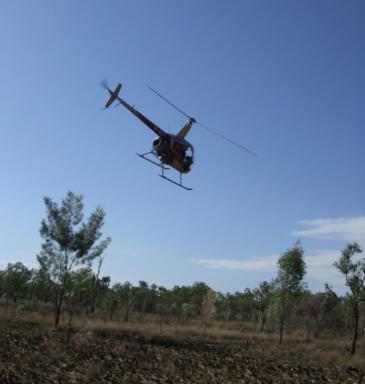
– end of article –
Orang-utans
Tags: Australian wildlife, Cave-dwelling Frog, conservation, CSIRO, Golden Bandicoot, Golden-backed Tree-Rat, Gouldian Finch, Kimberley, Monjon Rock Wallaby, Northern Quoll, Priority threat management, Scaly-tailed Possum, Spotted Tree Monitor, Stripe-faced Dunnart, The Wilderness Society, threat management, Western Chestnut Mouse, Wyulda
Posted in Bandicoots, Kangaroos and Macropods, Kimberley (AU), Mice (native) and Antechinus, Possums and Gliders, Quolls, Reptiles, Threats from Bushfire, Threats from Colonising Species | No Comments »
Add this post to Del.icio.us - Digg
|
|
 This is reducing the ‘hazard’
Click photo to enlarge, then click again to enlarge again and look for anything living.
After a year look for the animals.
After two years look for the animals….
This is reducing the ‘hazard’
Click photo to enlarge, then click again to enlarge again and look for anything living.
After a year look for the animals.
After two years look for the animals….






























































































